12 DAYS
Greetings for arrival
Transfer to Taipei for 1 day tour
Morning: Chiang Kai-shek Memorial Hall /Taiipei Longshan Temple /Taipei 101
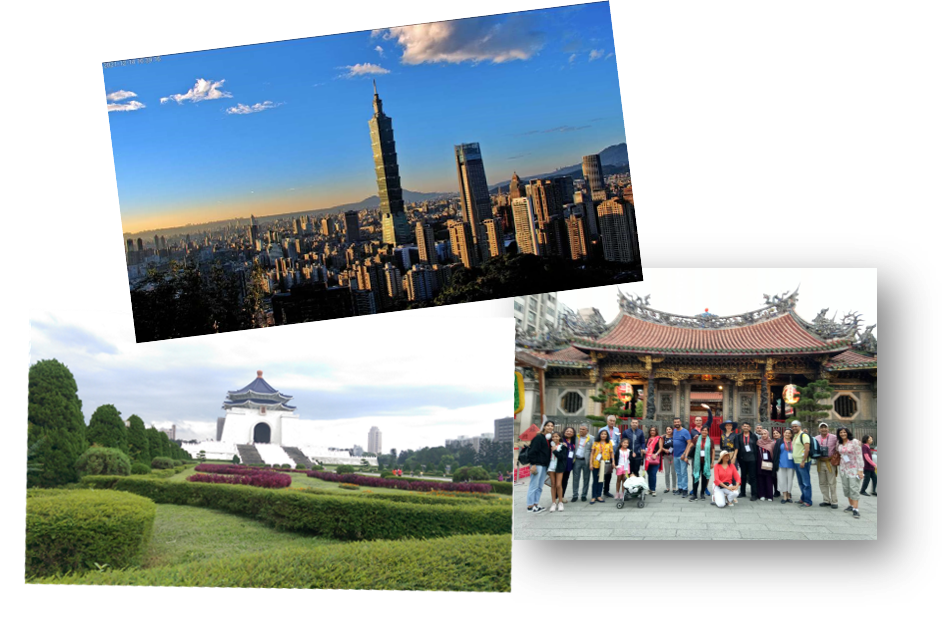
Afternoon: Miaokung Gondala / Tea House
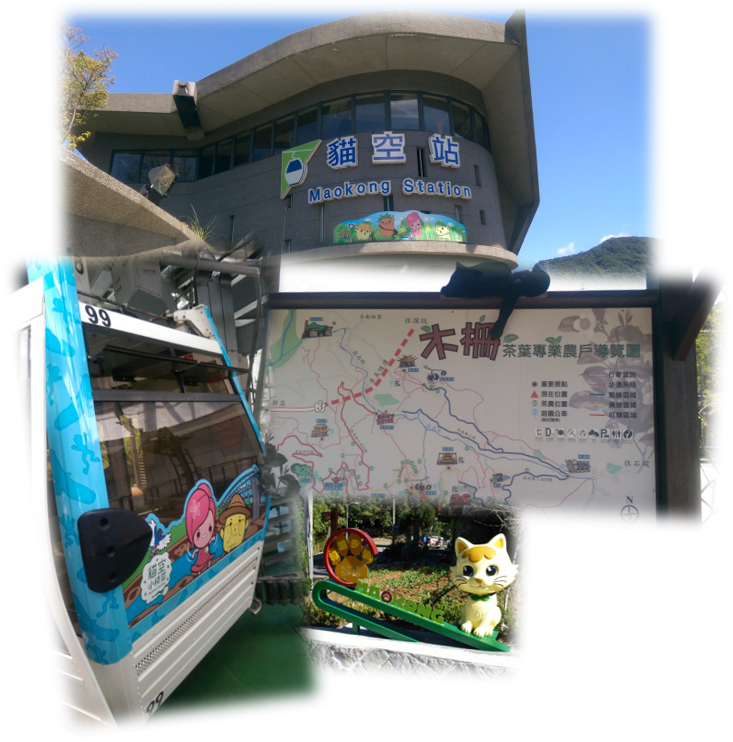
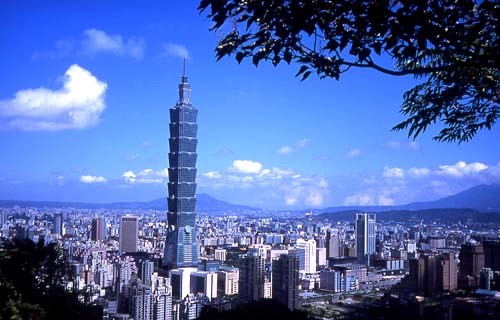
Taipei 101
The Taipei 101 is designed to resemble a growing bamboo stalk, a symbol of everlasting strength in Chinese culture.
Taiwan doesn't have many ostentatious records in its history, but Taipei 101, designed by local architect C.Y. Lee, brings one.
It was the first skyscraper to go past the half-kilometer mark and it sat at the pinnacle of the skyscraper world from 2004 to 2009.
Taipei 101 can also claim to have the world's fastest passenger elevator.
At an ear-popping 1,010 meters per minute, it takes 37 seconds to catapult passengers from the fifth floor to the highest point in Taiwan.
-
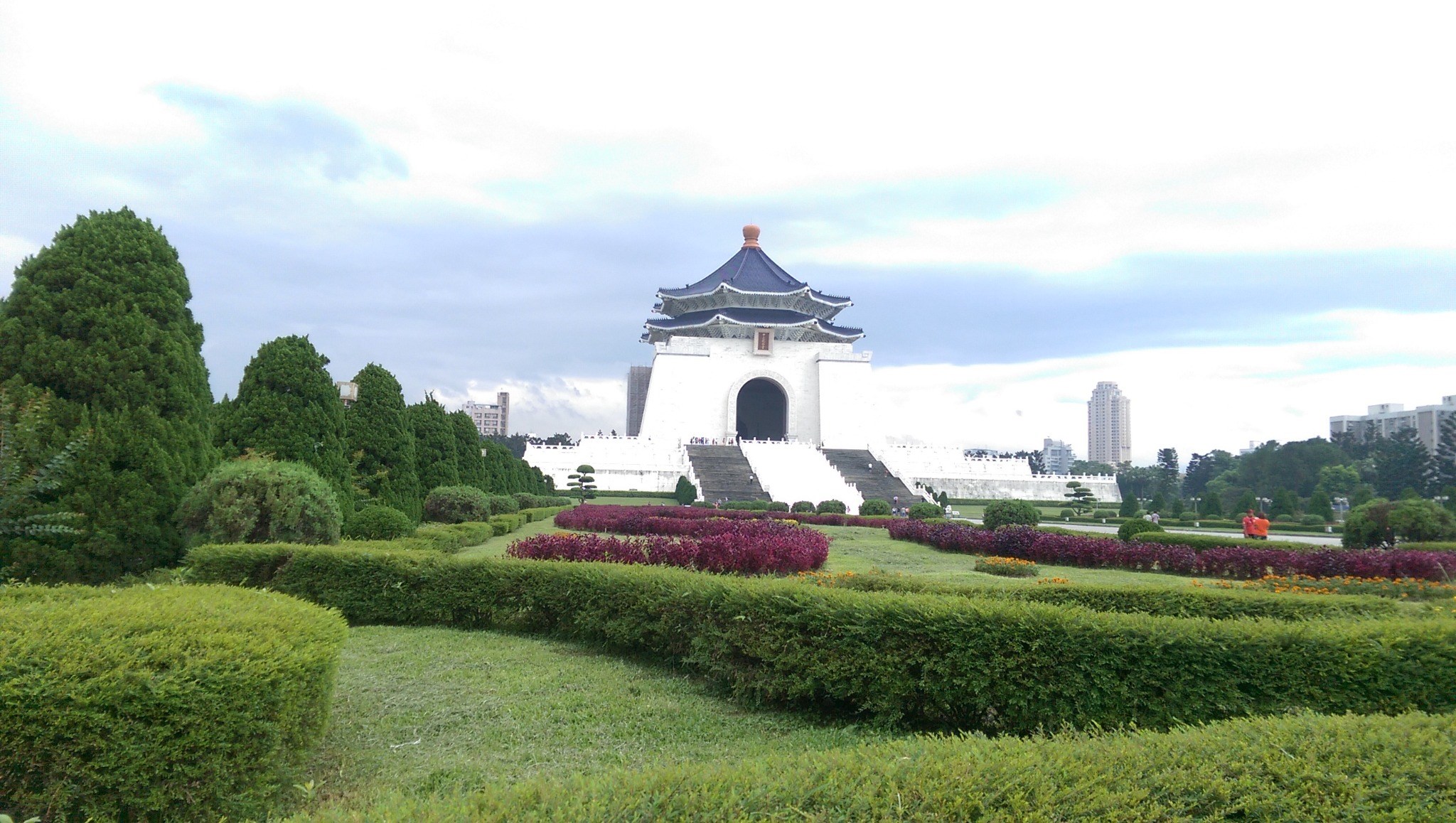
Chiang Kai-Shek Memorial Hall
The most prominent historical landmark in Taiwan, the CKS Memorial Hall was erected in honor and memory of Generalissimo Chiang Kai-shek, the former President of the Republic of China, and was opened in 1980 as part of a national park and gathering area.
The name of the square is officially Liberty Square (自由廣場), as seen above the front gate, however the name change was politically motivated and most people in practice still refer to the entire complex as CKS Memorial Hall.
The octagon-shaped white building rises 76 meters and is covered with blue tiles and red accents, echoing the flag of the Republic of China. The eight sides represent the Chinese cultural symbolism of the number eight which is traditionally associated with fortune and wealth. The two sets of 89 steps represent Chiang's age of death and lead up to main hall housing a large bronze statue of Chiang protected by military personnel which change hourly.
The characters behind Chiang's statue read "Ethics", "Democracy", and "Science", and the inscriptions on the side read "The purpose of life is to improve the general life of humanity" and "The meaning of life is to create and sustain subsequent lives in the universe".
Below the hall is a museum documenting Chiang's life and career, as well as exhibits about Taiwan's history, pan-Chinese culture and history, and the ROC's development after moving to Taiwan. -
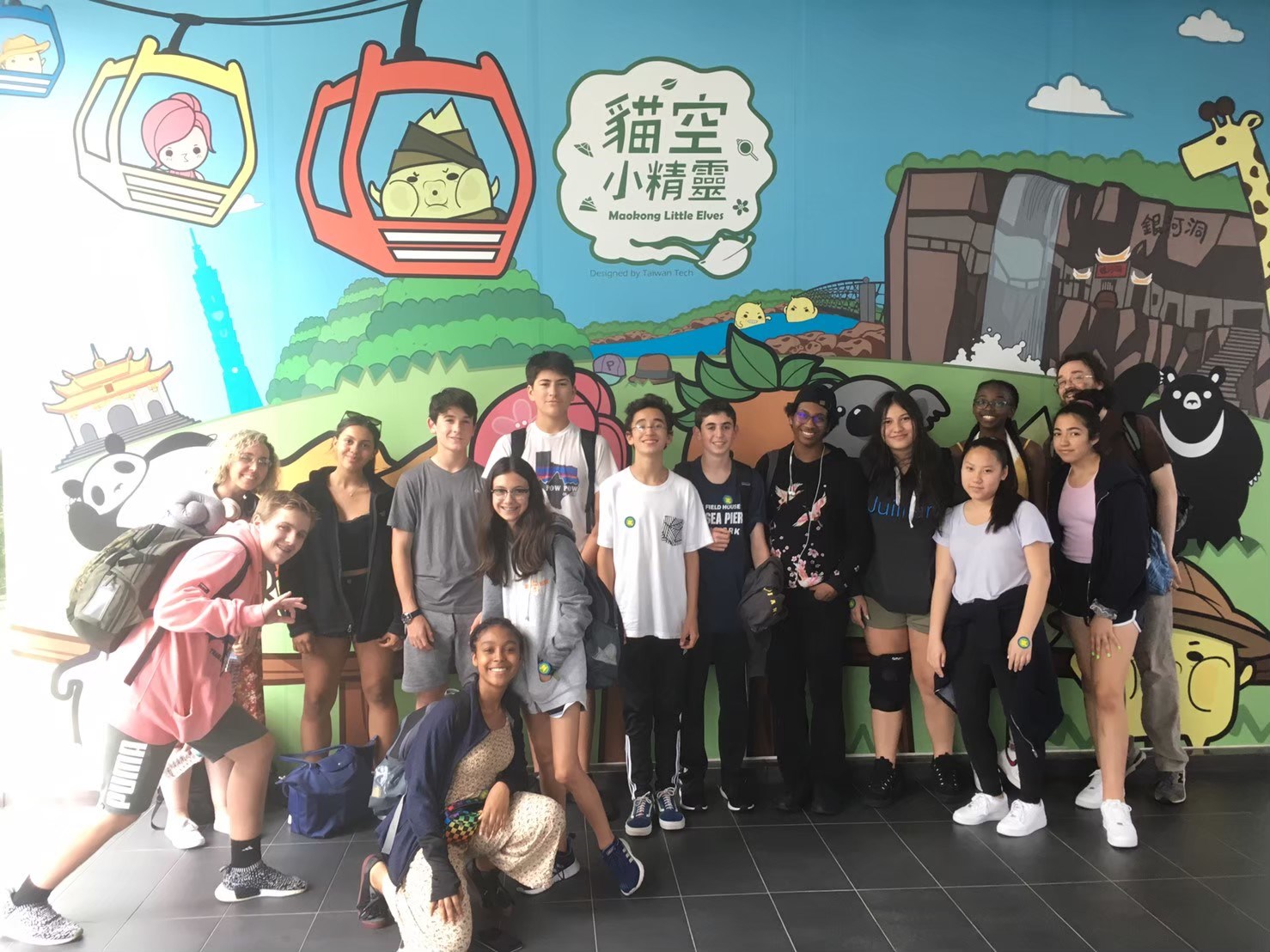
Maokung
Maokong is an area southwest of Getou Mountain in the Muzha District, on the outskirts of Taipei. Maokong refers to the lands in the valley around the Tea Research Center. One can see potholes in the area's streams, which are the erosional result of swirling sand and gravel. These formations are called "Lokang" (wrinkled hole) in the Taiwanese language. Japanese authorities during the colonial era gave it a similar-sounding name of Maokong. The area's closeness to National Chengchi University led to economic development, as students would often visit in the evening. This helped spur Maokong's very special brand of tea tourism.
The tea farms here are famous for Bouzhong tea and Taiguan Ing. There are many teahouses with diversified styles. They are good places to visit no matter during day or night. In the daytime, there are tea trees and hills forming green scenery. Many citizens visit the place by taking the mountain tracks. After dusk, Maokong is like an enchanting, mysterious lady. Colorful light bulbs are lit in front of every building. Visitors taste tea, chat with each other and admire the nightfall. Sometimes groups of young people have parties and the laughter brings a touch of vigor to Maokong.
The tea farms (open for sightseeing) are scattered around Lane 34, 38, 40 of Zhinan Road, Sec. 3, and the former half of Zhinan Road, Sec. 3. Most tea farms provide tea tasting or meals. Recently, the sightseeing industry blooms here. Many residents develop other means of livelihood other than tea farming. For example, they raise mountain chickens or provide country cuisine. Visitors coming here may also want to try the delicious dishes. -
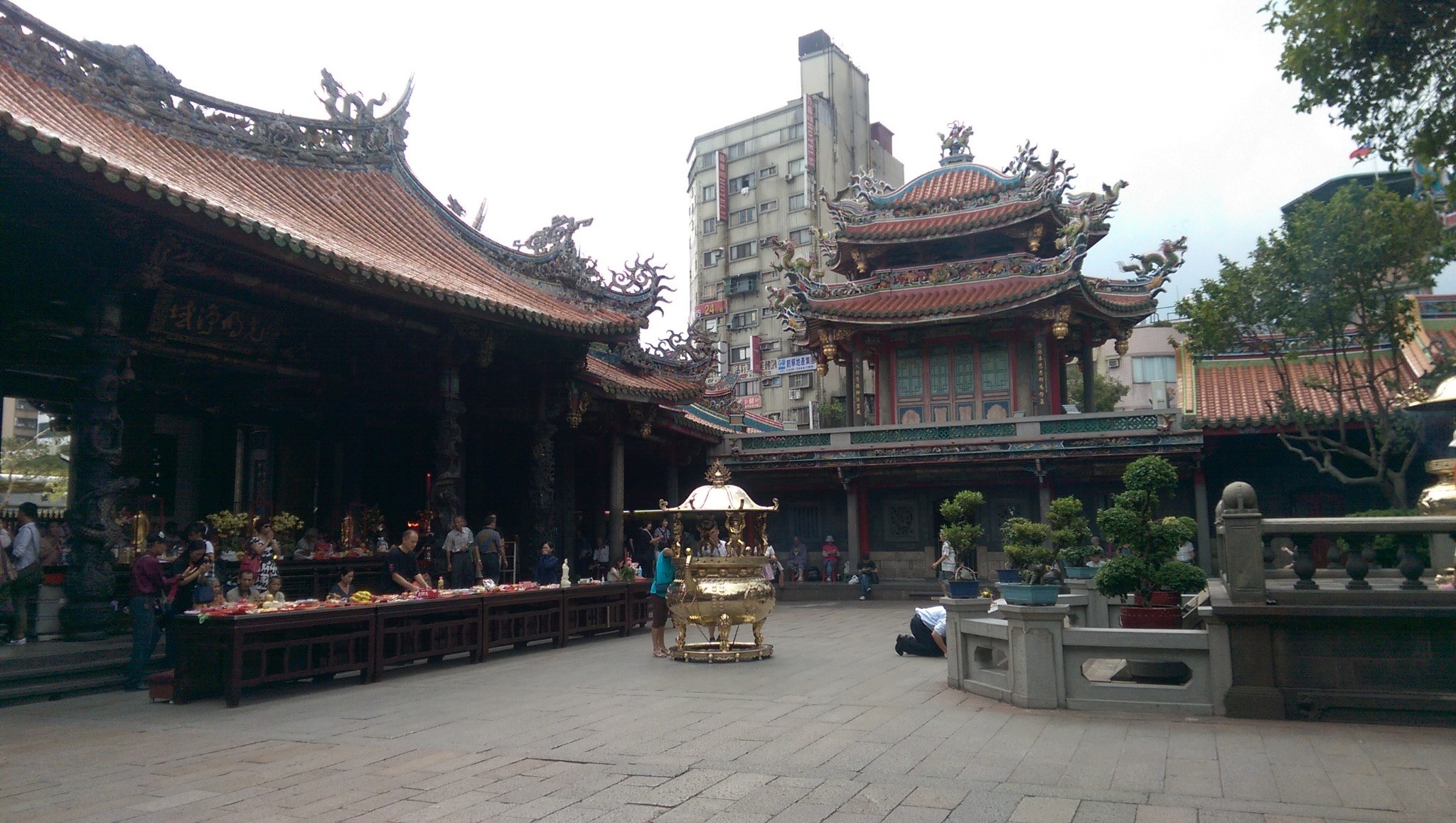
Lingshan Temple
Lungshan Temple is a famous old temple in Taiwan. It is for worshiping Guanshiyin Budda and other divine spirits. Lungshan Temple is facing the South. Its architecture is a three-section design in shape. There are the front hall, the rear hall and the right/left dragons protecting the middle hall. The layout is square and serene. The temple was built in 1740, during Qing Dynasty. Due to natural disaster and damages caused by men, the temple was restored for several times. The doors, beams, and poles are beautifully decorated. There is a pair of bronze dragon poles in the front hall, four pairs of dragon poles in the middle hall. The sculptures are delicate. There are also exquisite wood sculptures. Among them, the well and Budda setting in the main hall are highly appreciated. The temple has many Chinese poems, verses and lyrics on signs. These add a touch of literature in addition to the religious and sightseeing value.
There are great decorative lamp fairs and temple activities on historic festivals. On each 1st and 15th day each month of lunar year, regular visitors will come to the temple for worship ceremony. The temple attracts many people. At normal times, there are domestic/foreign tourists visiting the temple. Lungshan Temple is not only a temple, a sightseeing attraction, but also a national heritage site. There are traditional streets/shops, antique shops, Buddhists article shops, and Chinese medicine shops surrounding the temple. These places are great to visit due to their richness in folk art.
-
-
v
v
-
4-star or 5-star hotel in Taipei
Morning: National Palace Museum
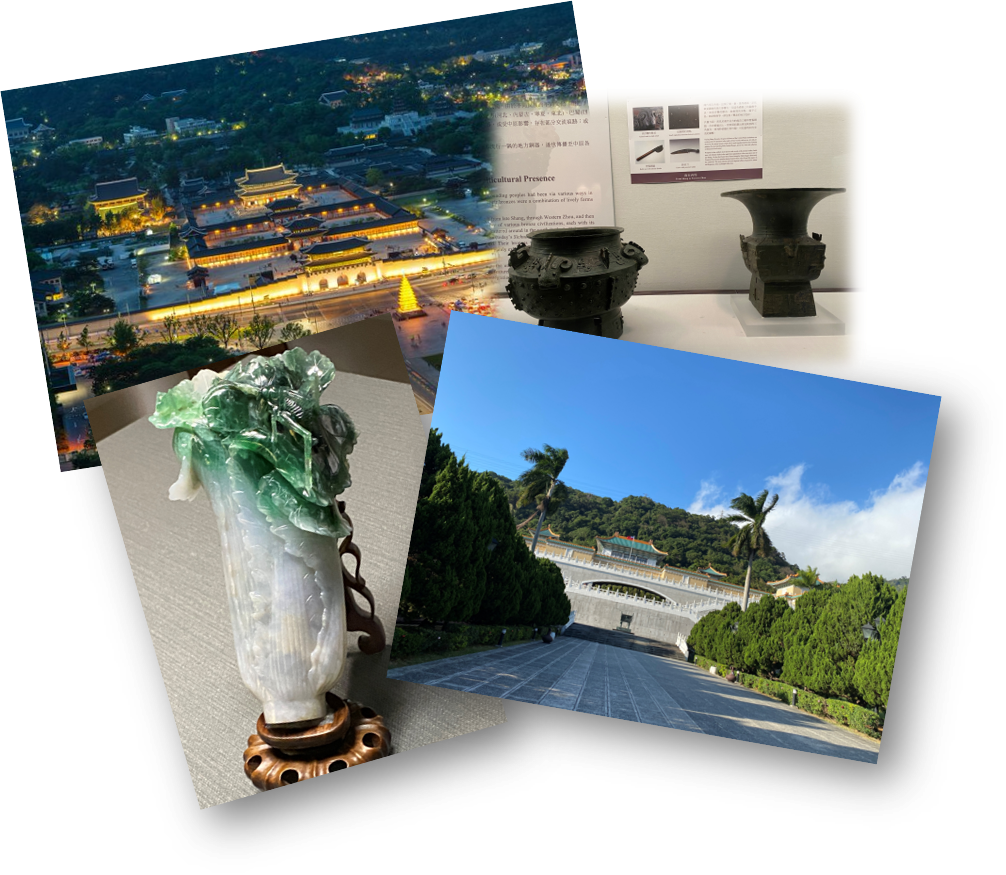
Afternoon: Daxi Old Street /National Taichung Theater
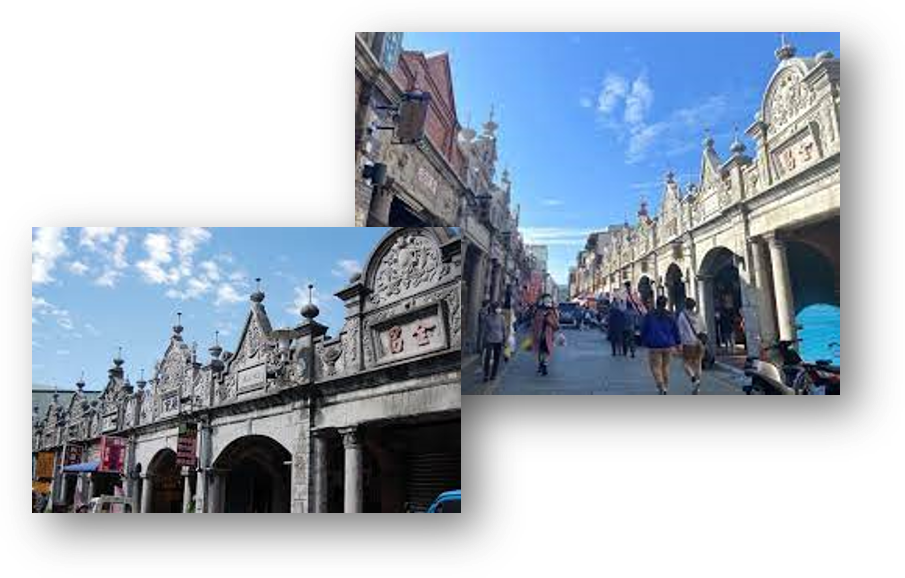
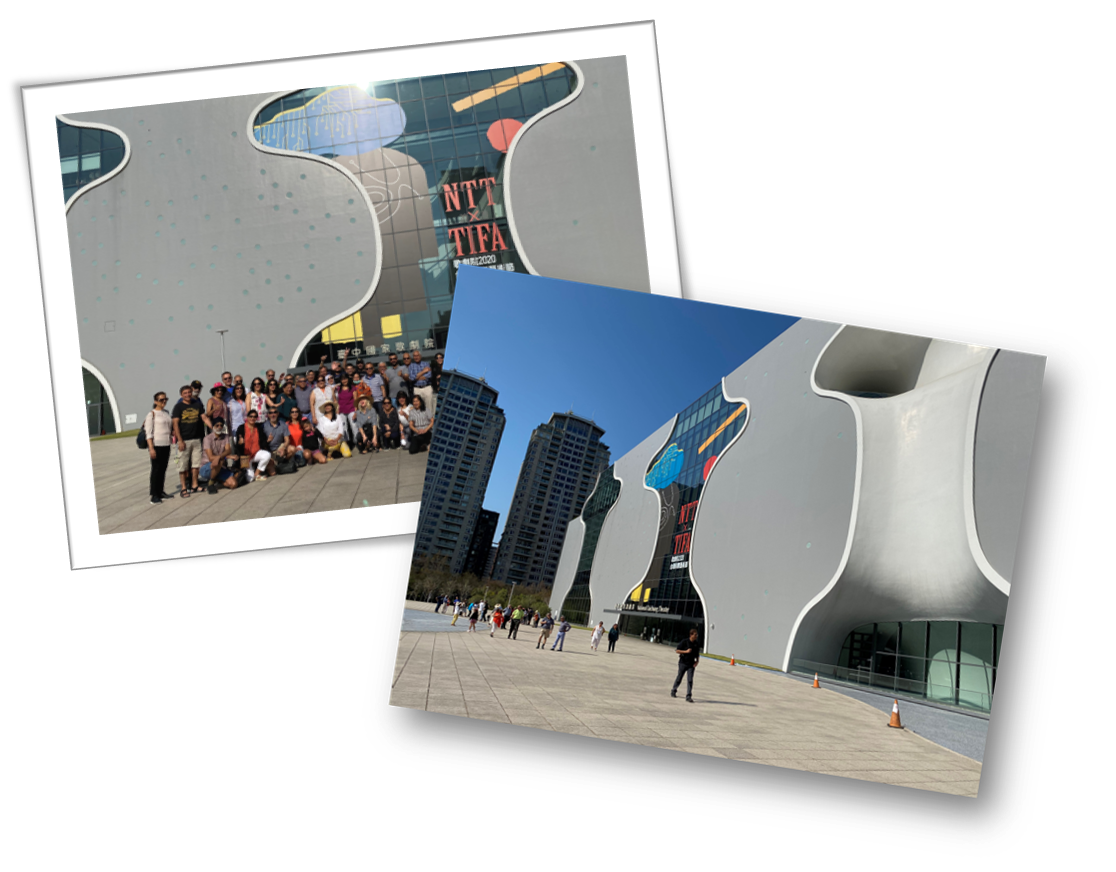
National Palace Museum
World's 20 most-popular museums - National Palace Museum Taiwan
The National Palace Museum displays the world's greatest and rarest collection of traditional Chinese art crafts and historical documents. These priceless treasures include ancient Chinese paintings, archeological remains of bronze weapons, ceramics, jade, sculptures, books and other antiques. With more than 700,000 items on display, many of which once belong in Beijing's Forbidden City. The National Palace Museum truly reflects the rich cultural heritage of Chinese civilization and ancient Chinese culture. The National Palace Museum was established in 1925 and was expanded and remodeled in 1965.
National Taichung Theater
The National Taichung Theater was designed by Japanese architect Ito Toyo. Based on the "sound cave" concept, elements such as curved-wall units and air holes are used to build this changed space. The result is a newfound building that stands on its own firmly without supporting pillars or 90-degree walls at all.
The theater is equipped with three professional performing venues which meet international standards: Grand Theatre, Playhouse and Black Box. They can each be adapted to fit the needs of various types of productions. There is also a multi-functional space, "Corner Salon," where educational events and public speeches may be held. The green Outdoor Plaza and the rooftop Sky Garden are great for the public to spend some leisurely hours in.
The architecture of the National Taichung Theater is a work of art. The theater's performing venues and garden are unique, too. It is worth paying a visit here for an artistic feast, from the inside out!
-
v
v
v
-
4-star or 5-star hotel in Taichung
Morning: Sun Moon Lake Tea Farm
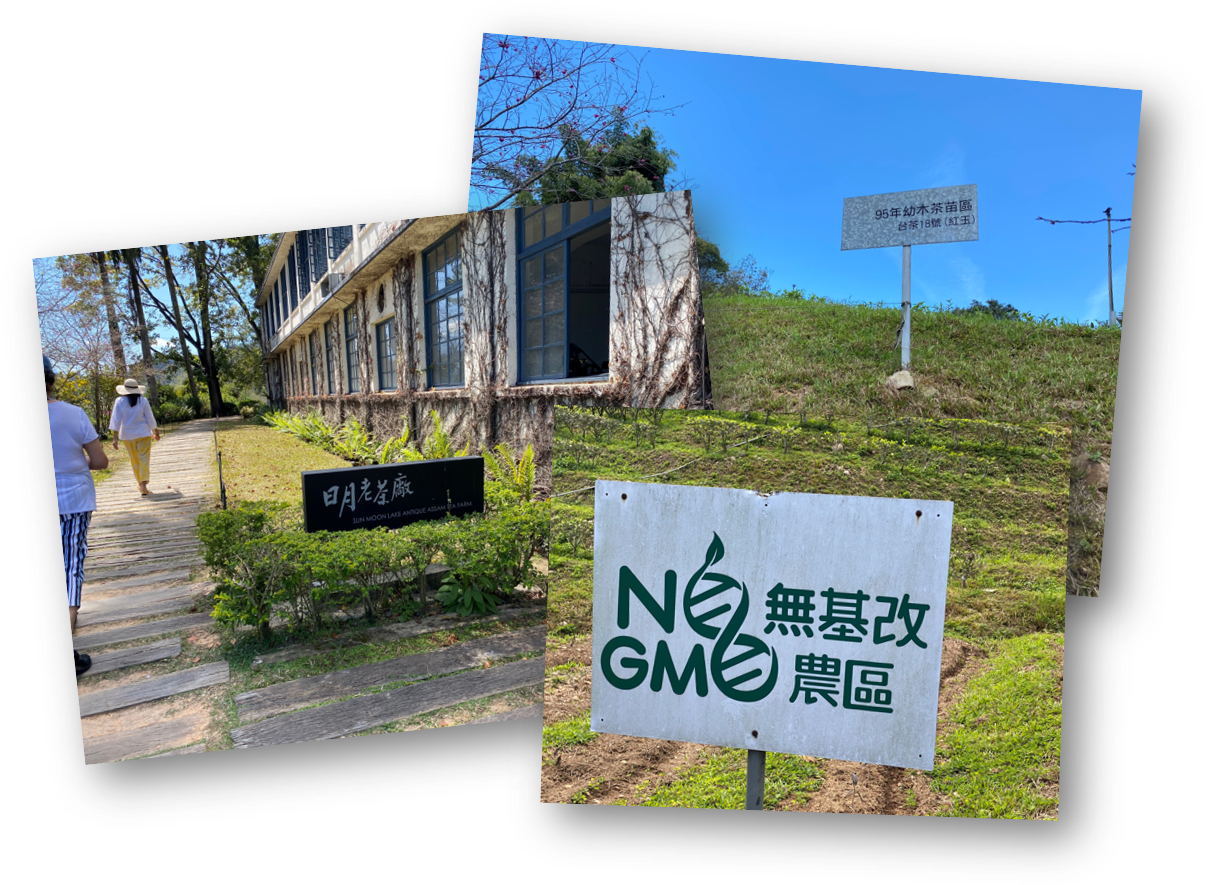
Afternoon: Shiangshan Visitors Center/Biking around Sun Moon Lake / Tzean Tower
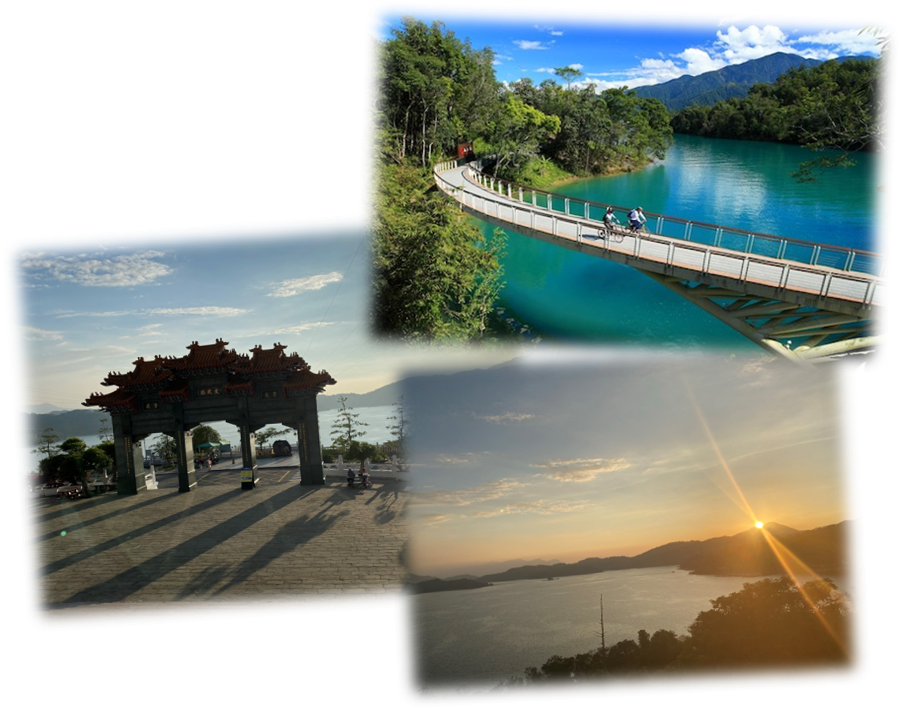
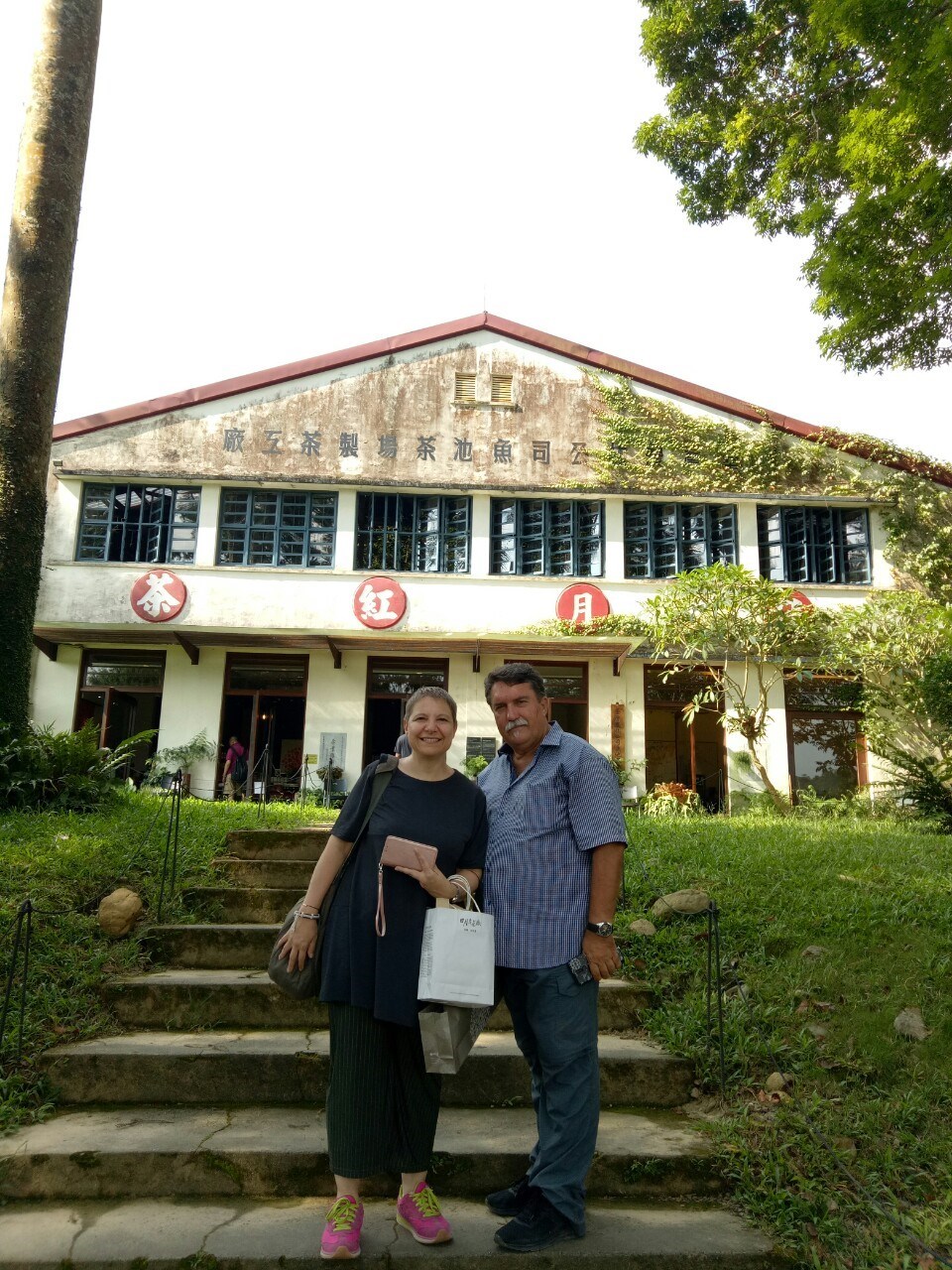
Sun Moon Lake Tea Farm
The lake’s surrounding soil, elevation and rolling fog provides the ideal environment for growing tea, so it’s no surprise that Sun Moon Lake has garnered international attention for its high quality tea. The region takes its tea very seriously, with a dedicated Tea Research and Extension center that supports scientists and local tea farmers to research, experiment, and improve tea plantations. Below, we introduce you to this tea paradise while providing recommendations for the best places to learn about and taste Sun Moon Lake’s tea.
Under colonial rule in 1917, the Japanese introduced the Indian assamica tea variety to Taiwan’s Sun Moon Lake and found that it thrived in a climate and altitude very similar to Assam, India. Today, this tea has become known around the world as fine, artisan black tea.
-
Sun Moon Lake
Sun Moon Lake, located in the middle of Taiwan, with an elevation of 748 meters above sea level, is the only natural big lake in Taiwan. The southern part of Lalu Island is shaped like a new moon, and the northern part is shaped like a sun; hence the name Sun Moon Lake.
-
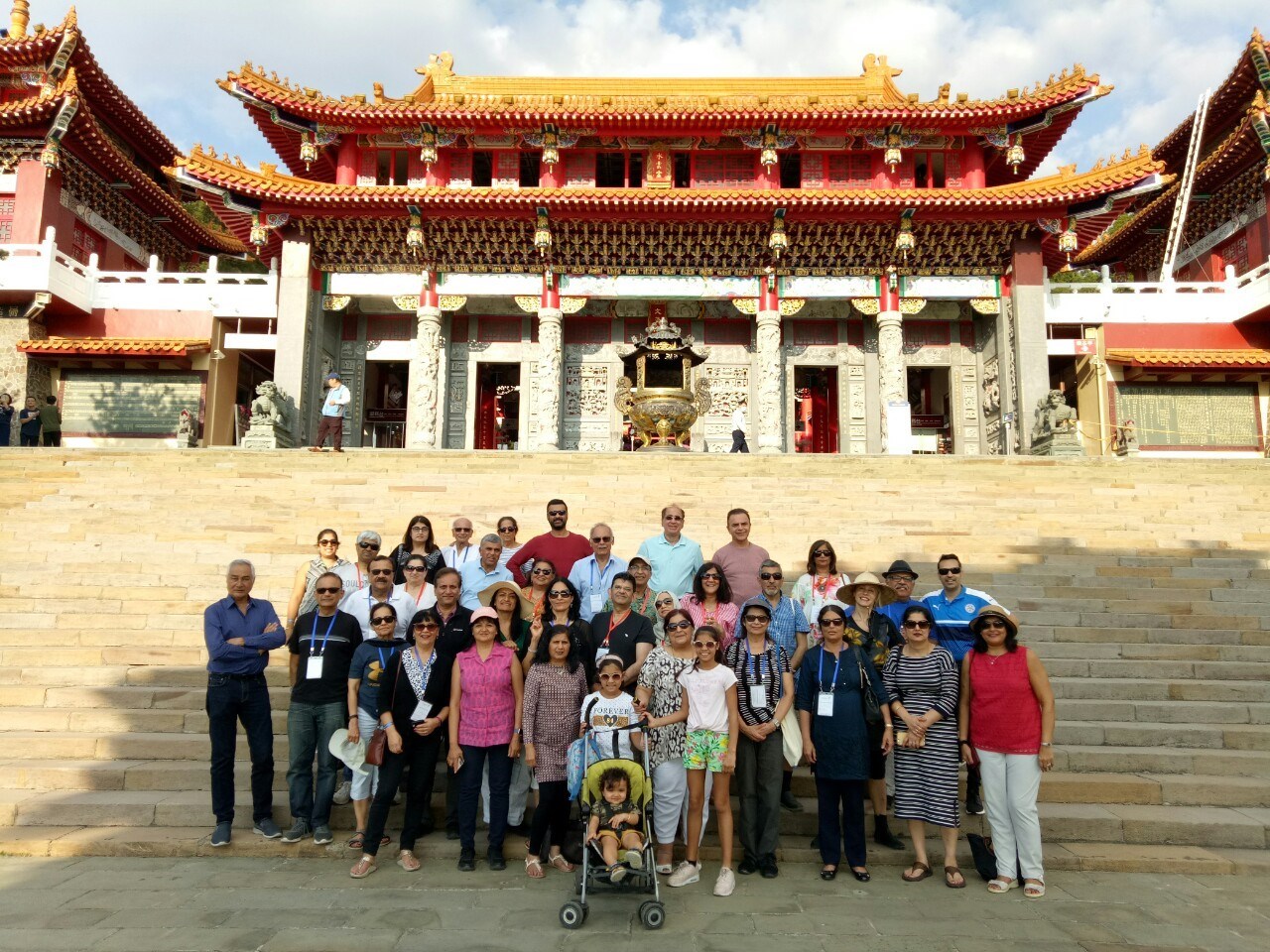
Wenwu Temple, Sun Moon Lake
Wenwu Temple is located at the shoulder of mountain where is on the north of Sun Moon Lake. It was built in 1938. People worried the water of Sun Moon Lake might cover Longfeng Temple and Yihua Hall of Shuishotsun(Ita thao Pier), they built Wenwu Temple. The Wenwu Temple is 2 (Longfeng Temple and Yihua Hall) in 1. It was rebuilt in 1969. Its gate is face to the north. People pray the Civil Saint of Confucius, the Military Saint of Guangong, and the Established God of two temples at the Wenwu Temple. The temple is popular among students.
-
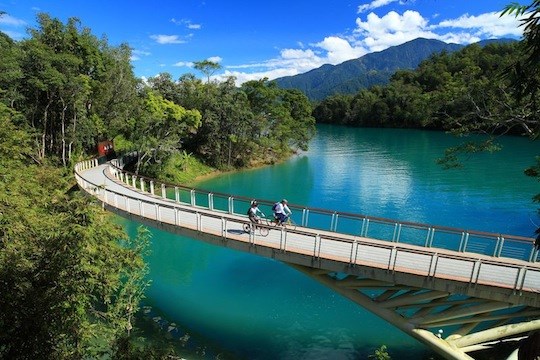
Sun Moon Lake Biking Routes
World's Top 10 breathtaking cycling routes - Sun Moon Lake
Located in the heart of Taiwan, the Sun Moon Lake has long been charming curious foreigners and local visitors alike. The route around the largest lake in Taiwan is a three-hour ride, where visitors can enjoy lake scenery, experience Thao aboriginal culture and learn about the local ecology in the Nantou County. If you arrive in early spring, you can even catch the cherry blossoms near this mirror-like lake.
-
v
v
v
-
4-star or 5-star hotel in Sun Moon Lake
Morning: Boat Trip around Sun Moon Lake
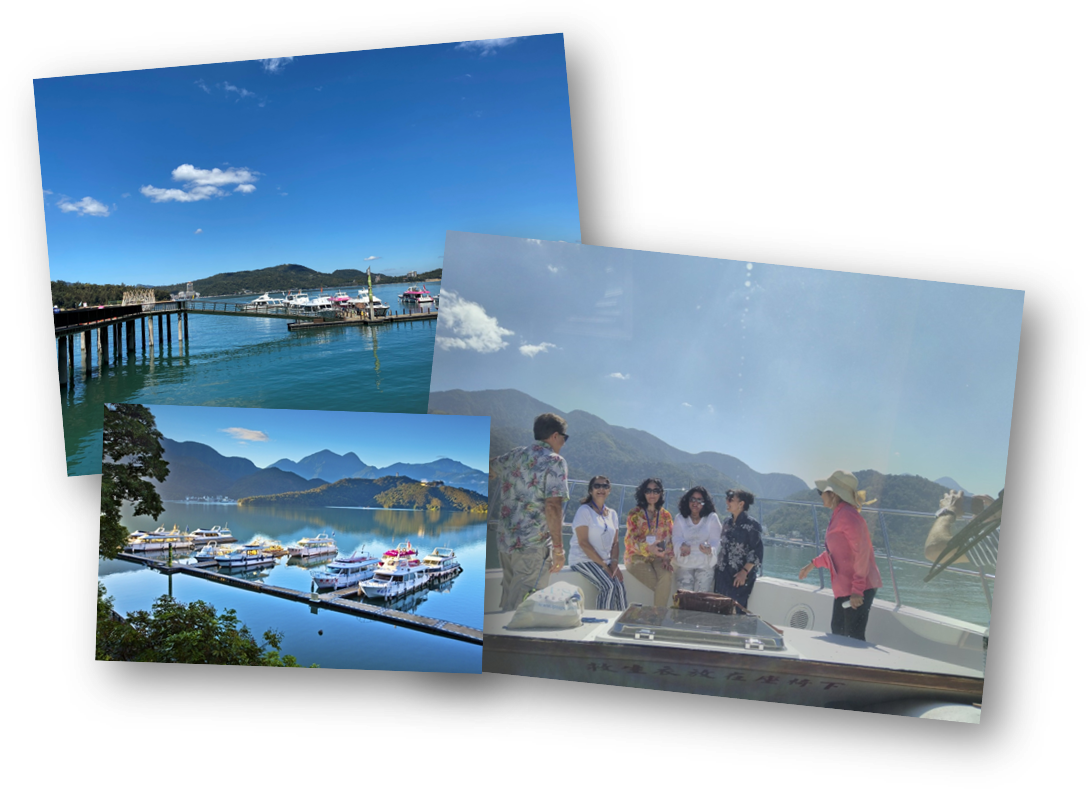
Afternoon: Lukang Old Street / Lukang Mazu Temple / Longshan Temple / Tainan
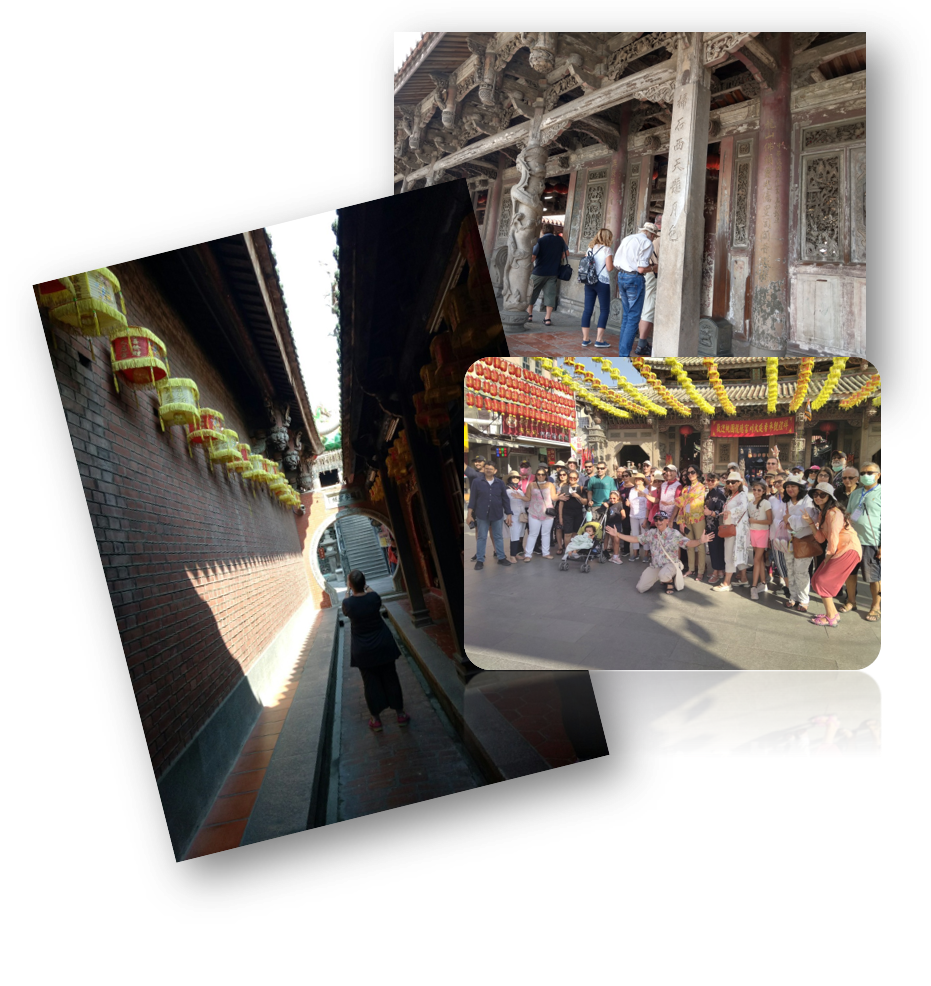
Sun Moon Lake
World's Top 10 breathtaking cycling routes - Sun Moon Lake
Located in the heart of Taiwan, the Sun Moon Lake has long been charming curious foreigners and local visitors alike. The route around the largest lake in Taiwan is a three-hour ride, where visitors can enjoy lake scenery, experience Thao aboriginal culture and learn about the local ecology in the Nantou County. If you arrive in early spring, you can even catch the cherry blossoms near this mirror-like lake.
Lukang Old Street
This street is made up of the curved, red-tiled lanes of today's Putou, Yaolin, and Dayou streets. Both sides of the streets are lined with newly renovated old-style shop buildings that feature intensely interesting internal room layouts and old-style exteriors. Here you can feel some of the atmosphere of old Lukang.
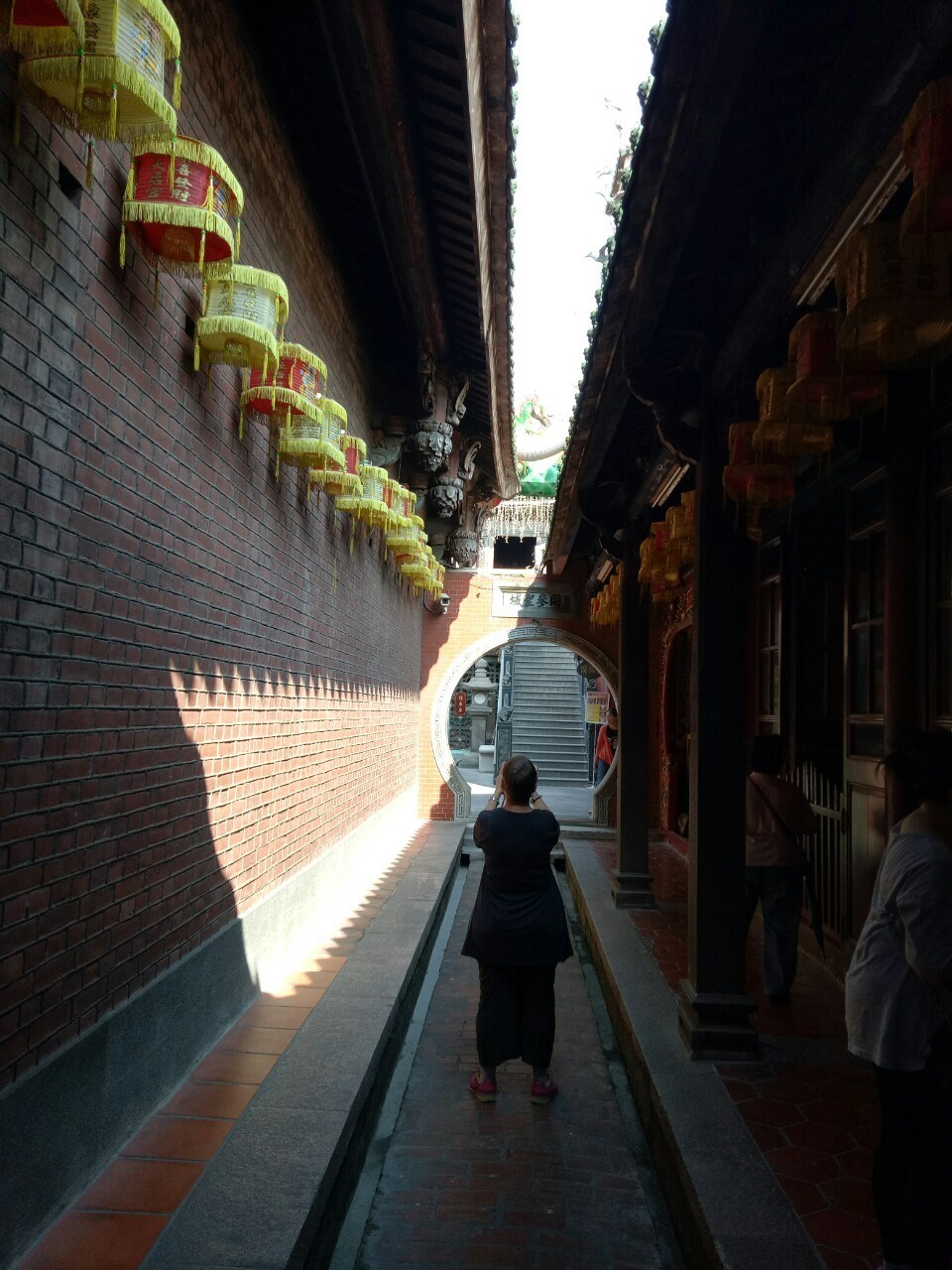
-
v
v
v
-
4-star or 5-star hotel in Tainan
Morning: Tainan Confucious Temple/ Koxinga Shrine/Eternal Golden Castle
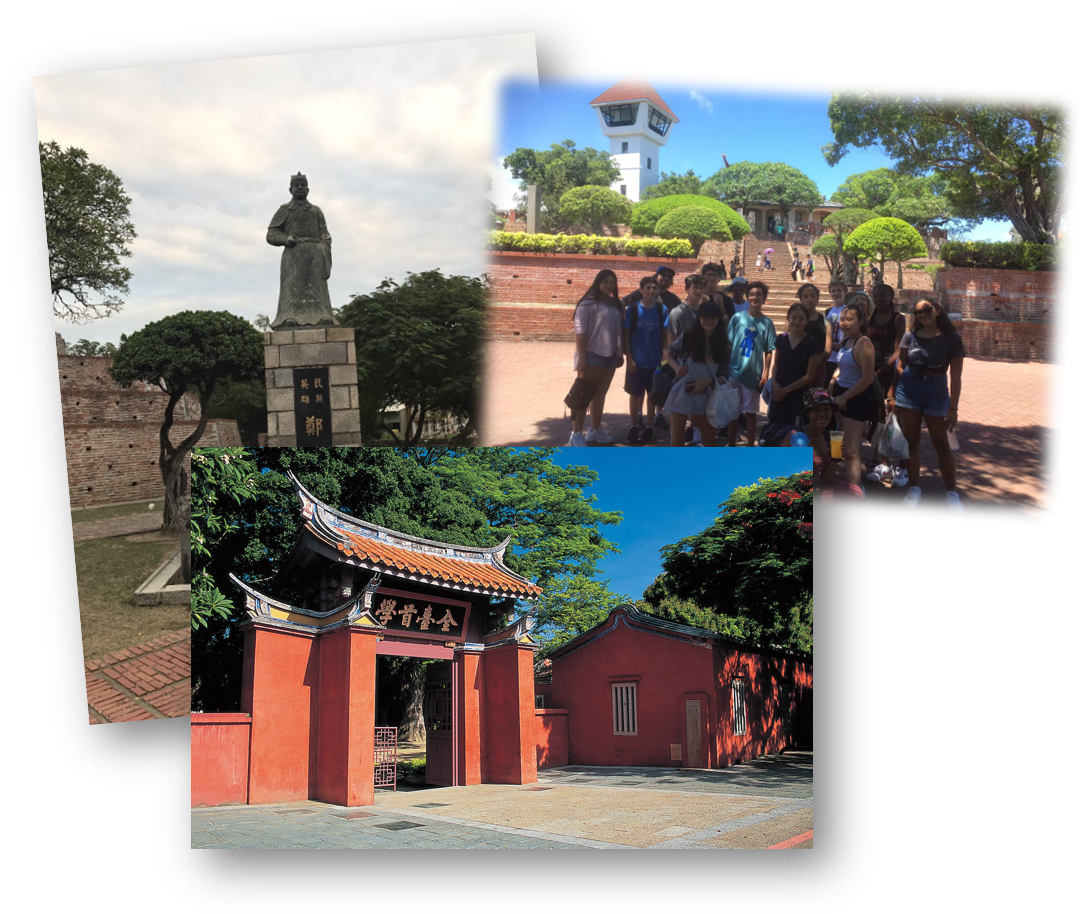
Afternoon: Anping Old Street /Anping Fort/Chihkan Tower
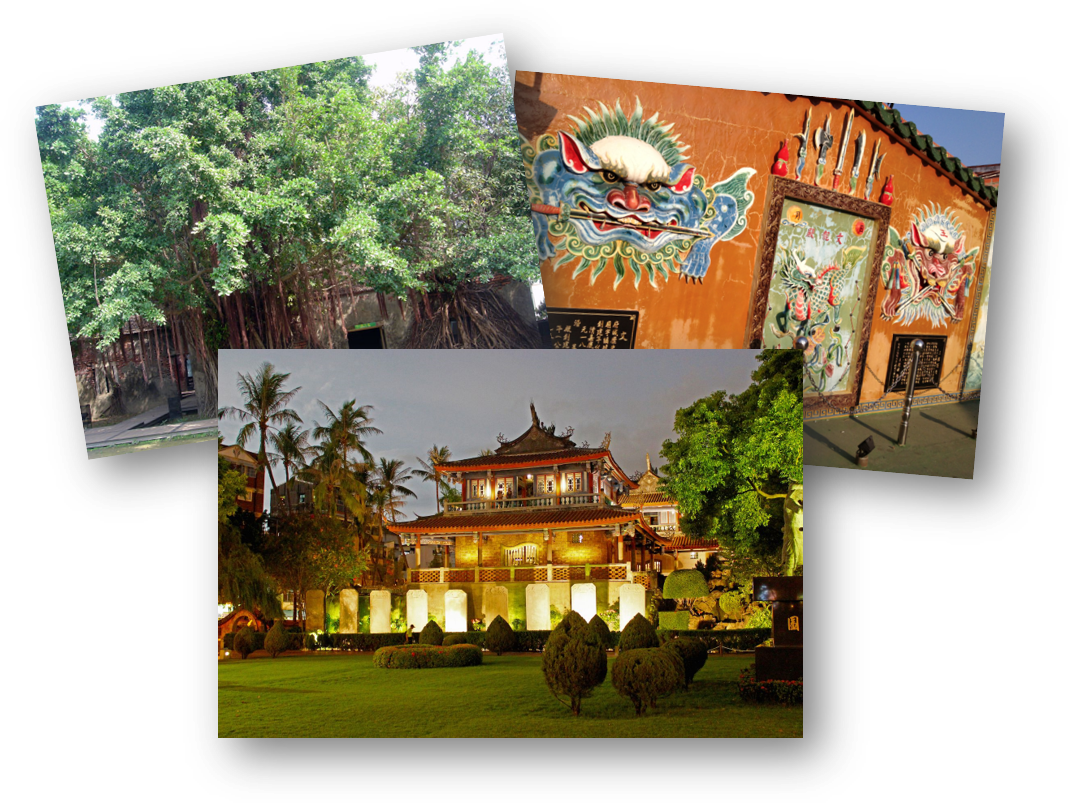
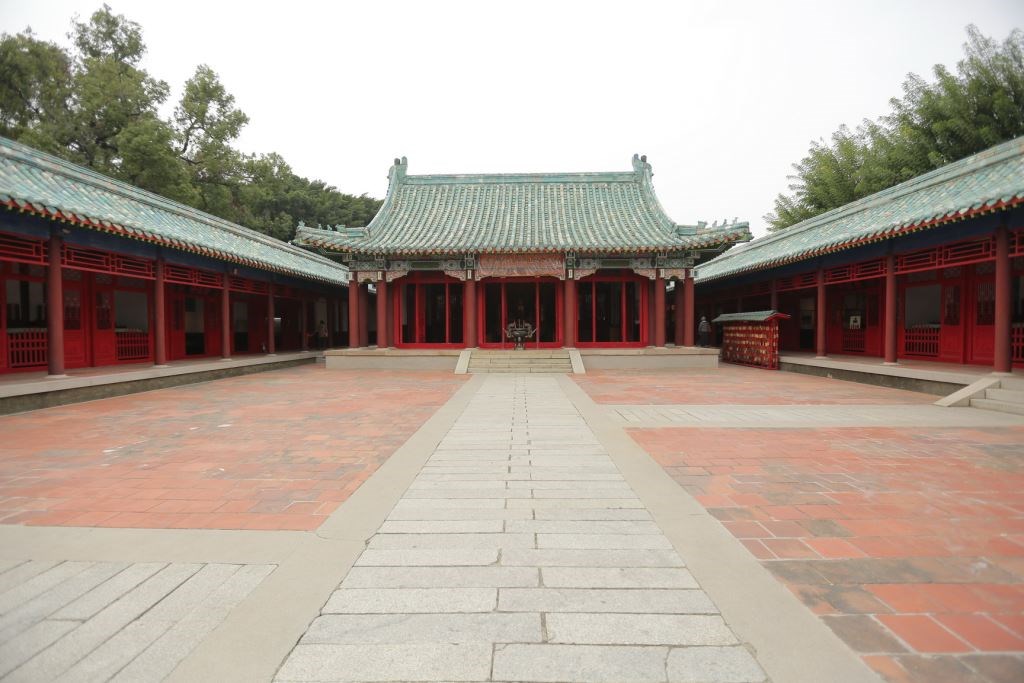
Koxinga Shrine
The Koxinga Shrine (Yanping Junwang Temple), located by Kaishan Road surrounded by trees, is the only Fujianese style shrine in Taiwan. This is the shrine built in memory of the work and achievement of Cheng Cheng Kung, the pioneer of Taiwan. Cheng Cheng Kung was originally called Cheng Sun, a native in County Fujian. His father, Cheng Chi Lung, was a wanderer in his early days. He has been a merchant as well as a pirate. His mother was a Japanese lady called Tagawa. Cheng was born with great intelligence. Not only was he diligent in his studies, he also has a huge ambitious to achieve something big, i.e. to become someone who are good in both academic work and in the military field. By the time he was 21 years old, Wu San Kuei led the Qing army into China and the Ming dynasty thus came to an end. As a result of his father surrendered to the Qing Dynasty and his mother committed suicide, Cheng Cheng Kung suffered a lot of pain and decided that he should turn against the Qing Dynasty to rejuvenate the Ming Dynasty in order to get rid of the shame caused by his father's traitor behavior. In April 1661, which is the 15th year of Emperor Yung Li's reign, he led his army crossing the Taiwan Strait and after 9 months' battle, had finally retrieved Taiwan from the hands of the Dutch. Taiwan thus was no more a colony of the Netherlands. After gaining access to Taiwan, Cheng quickly built up the whole place by setting up governing offices, regulations, education system as well as developing more farm lands to improve the living standards of the local people. He also actively trained people in military tactics, preparing them to fight the Qing army. However, just half year after he had retrieved Taiwan, Cheng died of illness on May 8, 1662. His aim of rejuvenating the Ming Dynasty was unfulfilled which was the biggest regret of his whole life. In 1874, which is the 13th year of Emperor Tongzhi of the Qing Dynasty's reign, emperor's special envoy Shen Bao Chen requested for the enlargement of the then existing Kai Shan Wang' shrine which was in memory of the work of Cheng Cheng Kung. It was approved by the regime and the new shrine was officially called "Koxinga Shrine" and for people to pay tribute to this folk hero.
Inside the Koxinga Shrine, there is the Koxinga Museum where exhibits various historical culture of Tainan. The first floor is for pre-historic preserves and dig-ups. Apart from illustrating the geographic connection between Taiwan and the Mainland, these things also describe the evolution of life from the past to the present. Most of the exhibits in the second floor are the historical materials of Tainan. These include the materials and things related to the concerned ancestors, such as the portraits of Cheng Cheng Kung and Shen Bao Chen, and also their works. In addition, daily items of Tainan city of the old like the street signs, bedding equipment, land deeds, money bills are on exhibition so that the public can understand the daily life of the past generations. It is a cultural spot very worth visiting.
-
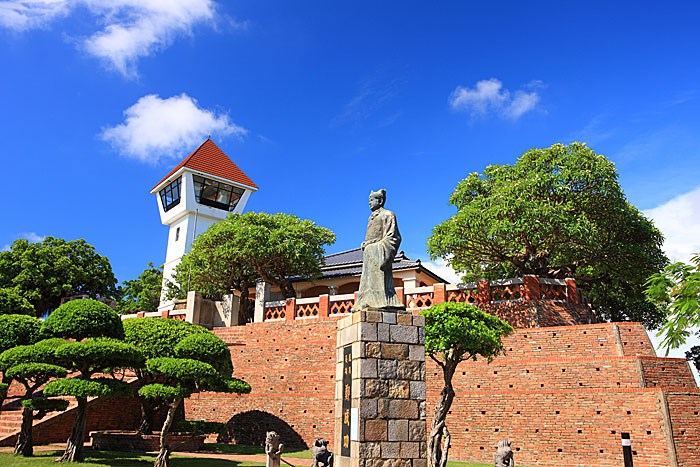
Anping Fort
In 1624, Dutch built the first fort in Anping, Taiwan, called "Fort Zeelandia", now known as Anping Old Fort, where has been the administrative center of the Dutch regime, and the hub for trading. The building was originally constructed in square inner fortress and rectangle outer walls. In 1661, the fort was renamed as Anping to commemorate his home town when Koxinga (Cheng Cheng Kung) has driven the Dutch out of Taiwan. Therefore, Fort Zeelandia was also known as "King's Fort" or "Taiwan Fort", nicknamed Anping Old Fort.
In Kangxi Emperor's regime of Qing Dynasty, Taiwan was included in the empire that the political center was transferred to Tainan City, causing the decline of the Fort. The red bricks of the Fort have been taken for construction of Eternal Fortress. During the Japanese occupation, the Dutch style buildings in inner fortress were completely destroyed. A square red-bricked step platform was constructed with a western style house on the platform, being served as dormitory for Customs officials, where the memorial hall now is located. It was named Anping Old Fort after Restoration of Taiwan and become an attraction for tourists. The remaining more than 70 meters long south walls of the outer fort with worn-out red bricks, accompanied by the old banyan roots, chanted its odyssey. The fort is the very historical replica over three hundred years. -
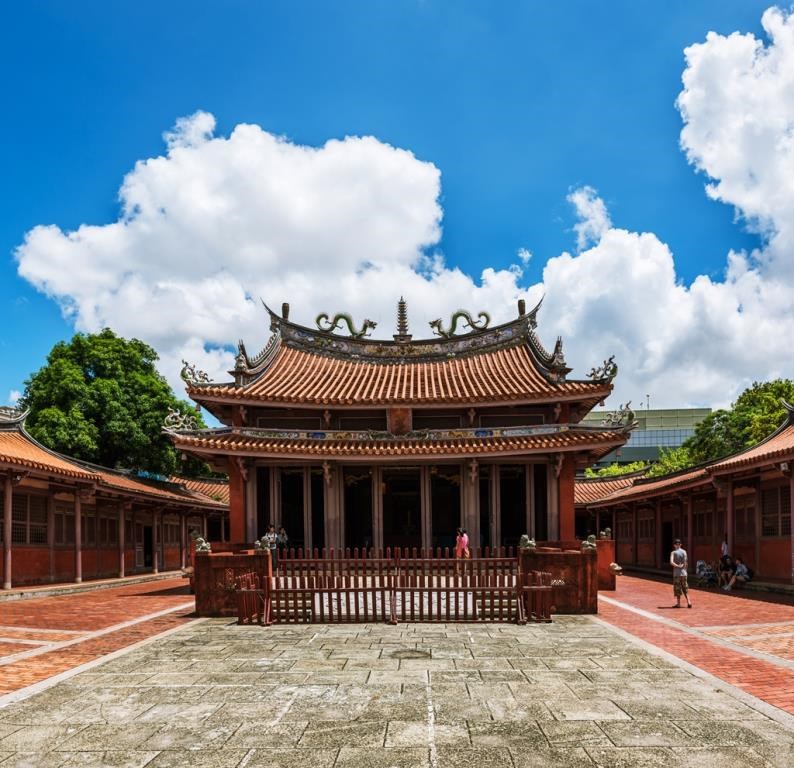
Confucius Temple in Tainan
The Confucius Temple in Tainan was built in 1666, it was the first Confucius Temple, before the end of Manchu Dynasty, it was the location of the highest official institute of higher learning in Taiwan. The Taiwan Palace of "Confucianism Study," it owned the incompatible position of culture and education, and was called "The Highest Institute." The Confucius Temple has been through more than thirty times of reconstruction, a part of the building was destroyed during the wars or ruined by nature disasters; the present scale of the Confucius Temple was the look after reconstructing during the time when Japanese were ruling (1917), its elegant and simple localization characteristic takes a distinctive attitude of its own among the Confucius Temples buildings in Taiwan. There are fifteen structures inside the Confucius Temple, the primary sacrifices in the palace is to Confucius divine tablet, on both sides, the sacrifices are to the sixteen pupils of Confucius.
Between the beams and pillars, there hang twelve horizontal described boards awarded by sovereigns of all dynasties since early Manchu Dynasty till today, it is the Confucius Temple in Taiwan to own the most complete royal horizontal described boards of all dynasties. Inside the temple, there are very old trees towering, classical elegant and tranquil, self-becoming a place of its own, the whole space presents a cultural breath, and is presently ranked among the national historic spots. Speaking of the preservation of the cultural articles in the Confucius, the inscriptional records through all times of repairs, the horizontal described boards awarded by sovereigns of all dynasties, and ceremony and musical instruments from early Manchu Dynasty till nowadays are still kept perfectly, and these are all very precious historical cultural articles that deserve to be carefully appreciated. -
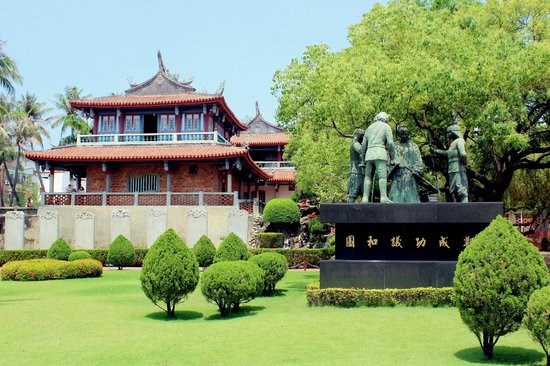
Chikan Tower
Tainan Chikanlou is built by the Dutch in 1653. It was originally called Provintia. In Dutch it means eternity. The Chinese called the building "Chikanlou", "Fanzailou" or "Honmaolou". Although Chikanlou has gone through Ming Dynasty, Qing Dynasty and the Japanese Colonization Period, it basically still maintains its original look.
Chikanlou has been an administration center from the Dutch's occupation period. In 1661, when the Chinese General Cheng Cheng kung repelled the Dutch, Provintia was changed to be Chentien governor's mansion. In the early stage of Qing Dynasty when Taijiang River was still running, the tides could reach Chikanlou directly. "The sunset in Chikanlou " was one of the eight famous scenes in Taiwan. In front of Chikanlou there are nine sets of stone turtles carrying plates. There were made in Qing Dynasty and were removed from elsewhere to be located here. The legend says that the stone turtle is one of the dragon's nine sons. It shifted into a turtle because it loved to endure heavy objects. There is also a stone horse with broken legs. The legend says that the stone horse's legs were broken by force because it shape-shifted into a monster at night and harassed the residents. Later, Chikanlou declined due to damages caused by civilian upheaval and lack of management. Chinese style building was added to the original Dutch architectural body. For a time the place hosted the worship for Guanshiyin Budda. During the Japanese colonization period, Chikanlou was changed to be army hospital. There were some restoration and repair. After Taiwan was returned to R.O.C., the wooden structure was changed into steel concrete structure. The main entrance was changed. Thus they created the look of Chikanlou today.
-
v
v
v
-
4-star or 5-star hotel in Tainan
Morning: Foguanshan Monastery
Afternoon: Lotus Lake/National Kaohsiung Center for Arts(Weiwuyin)/Pier 2/Foromosa Subway Station/Liuhe Night Market
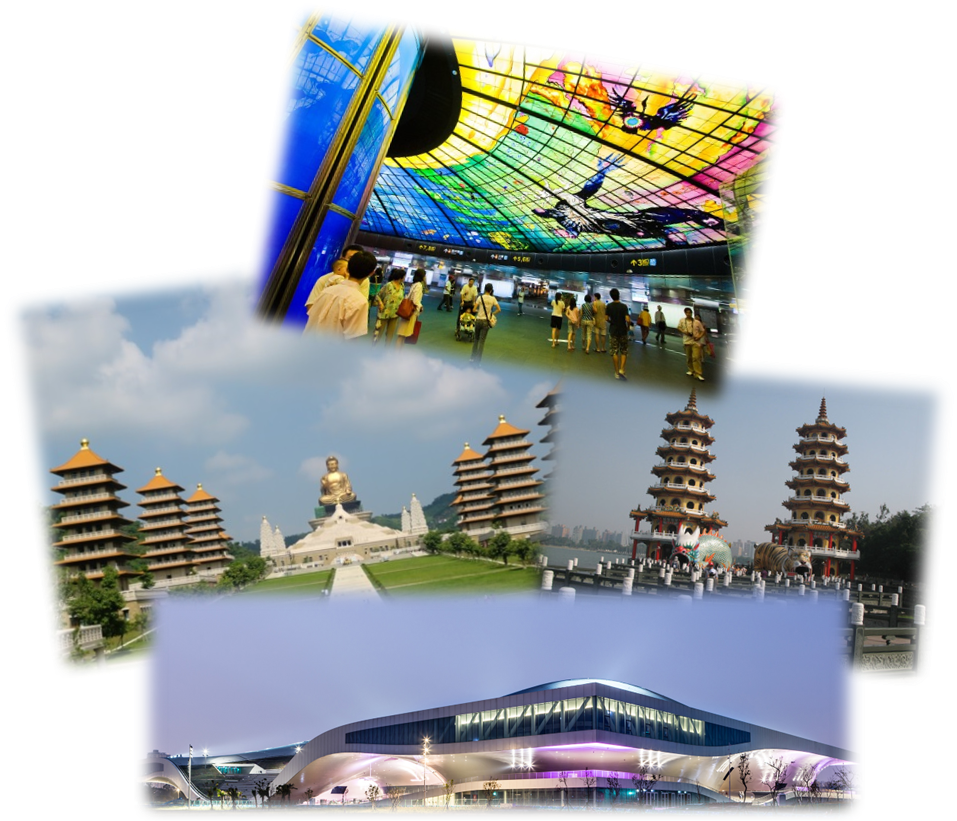
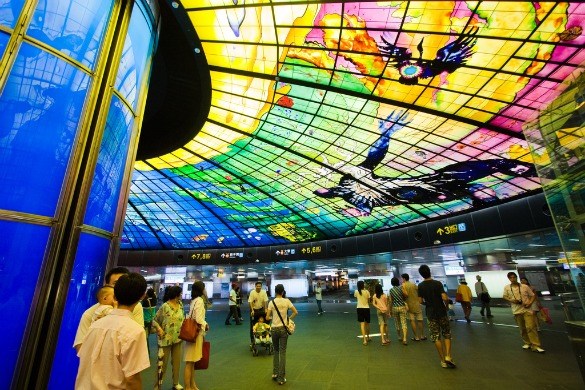
Dome of Light
Situated at the Kaohsiung MRT transfer station for the Red Line and Orange Line (Formosa Boulevard Station), the Dome of Light was created by renowned artist Narcissus Quagliata. The dome is the world's largest public art installation made from individual pieces of colored glass. The work not only adds to the beauty of the station, but also adds a new dimension to the art life of the Kaohsiung and creates a new scenic spot in the city.
The Dome of Light took nearly four years to complete. The work was overseen personally by Quagliata and shipped from Germany for installation at the station. The dome tells the story of human life in four chronologically arranged themes: Water: The Womb of Life; Earth: Prosperity and Growth; Light: The Creative Spirit; and Fire: Destruction and Rebirth, with an overall message of love and tolerance.
The dome has a 30-meter diameter and covers an area of 660 square meters. The lead glass panes were created and assembled according to a full-scale blueprint created by Quagliata to produce a creative new departure from this millennia old art form.
-
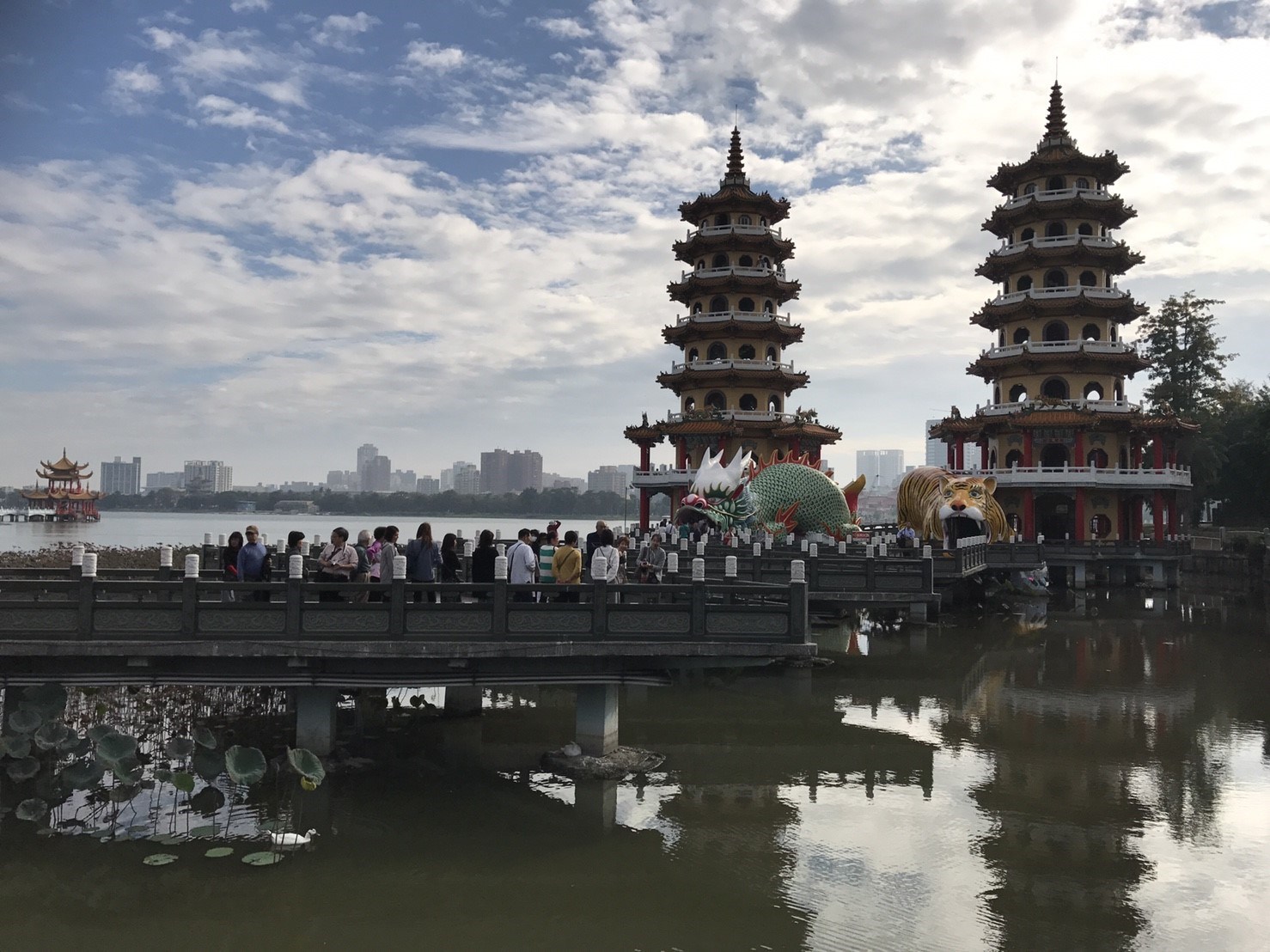
Lotus Pond
Lotus Pond
This famous scenic area on the northern outskirts of Kaohsiung City is noted for its profusion of temples, with the Confucius Temple at its northern edge and, in the south, the Dragon and Tiger Pagodas and the Spring and Autumn Pavilions. The pond is most beautiful in the late afternoon, when the setting sun is reflected in the water. Nearby are the ruins of the Fengshan County walls and gates, which have been designated a first-grade historic.
Spring and Autumn Pavilions
Two massive pavilions dedicated to Kuan Kung, the God of War, the Spring and Autumn Pavilions were completed in 1951. In front of the pavilions is a statue of Guanyin, the Goddess of Mercy, riding a dragon. According to legend, Guanyin appeared above the clouds riding on a dragon, signifying that believers must erect an image depicting this event between pavilions of summer and autumn: The present-day structures are a result of this vision.
Dragon and Tiger Pagodas
About 700 meters to the south of the Spring and Autumn Pavilions are the Dragon and Tiger Pagodas. The dragon's throat is the entrance and the tiger's mouth is the exit. Entering a dragon's throat and coming out a tiger's mouth symbolizes turning bad luck to good fortune. Inside, paintings depict China's 24 most obedient sons as well as scenes of heaven and hell to inspire people to do good deeds during their lifetime, and to provide threatening examples of retribution for wrongdoing. -
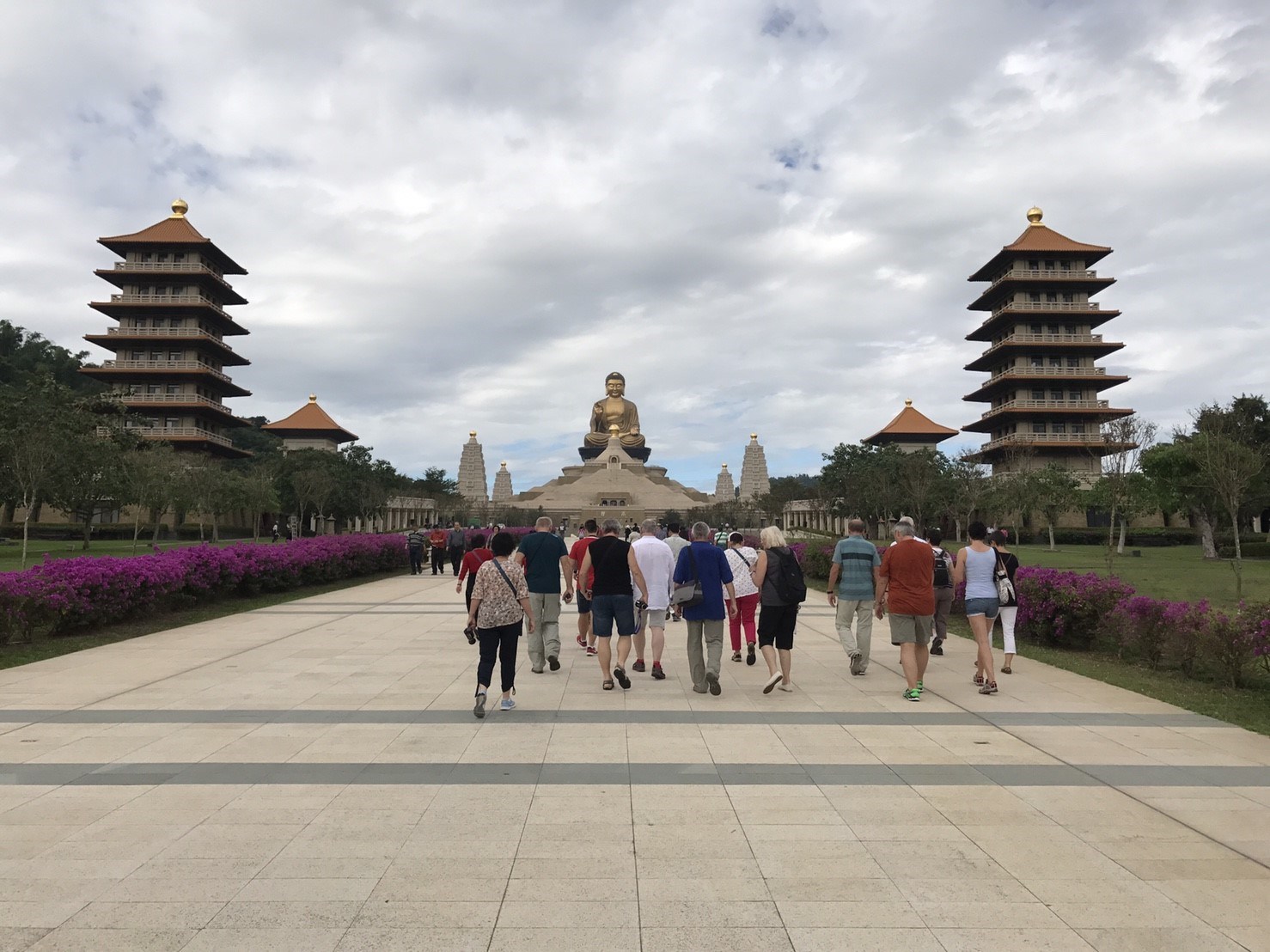
Fo Guang Shan Monastery
At the north-east of Dashu Township in Kaohsiung City on the left bank of the Gaoping river, a famous tourist destination is located. Here you will find the Buddhist center of South Taiwan, established my Master Hsing Yun and his disciples. The architecture of the temples is very characteristic, and at the southeastern side of Fo Guang Mountain (Guang Shan) Monastery the most prominent landmark of the region is found: a huge golden statue of Buddha Amitabha which measures some 120 meters. The main square is surrounded by 480 standing Buddha's, while water and mountains form the magnificent scenery. The main structures consist of four temples, namely the Daxiongbao, the Dabei, the Dazhi and the Dashu shrines. The Daxiongbao shrine covers a large area and is the most imposing of all four shrines. The main god of worship here is Sakyamuni, while statues of Amitabha is placed on the left and right sides. More than 10,000 Guanyin statues surround the temple. Buddha statues and lanterns of light rest in the 14,800 holes in the walls of the four shrines. The site counts more than a thousand Buddha statues, large and small.
-
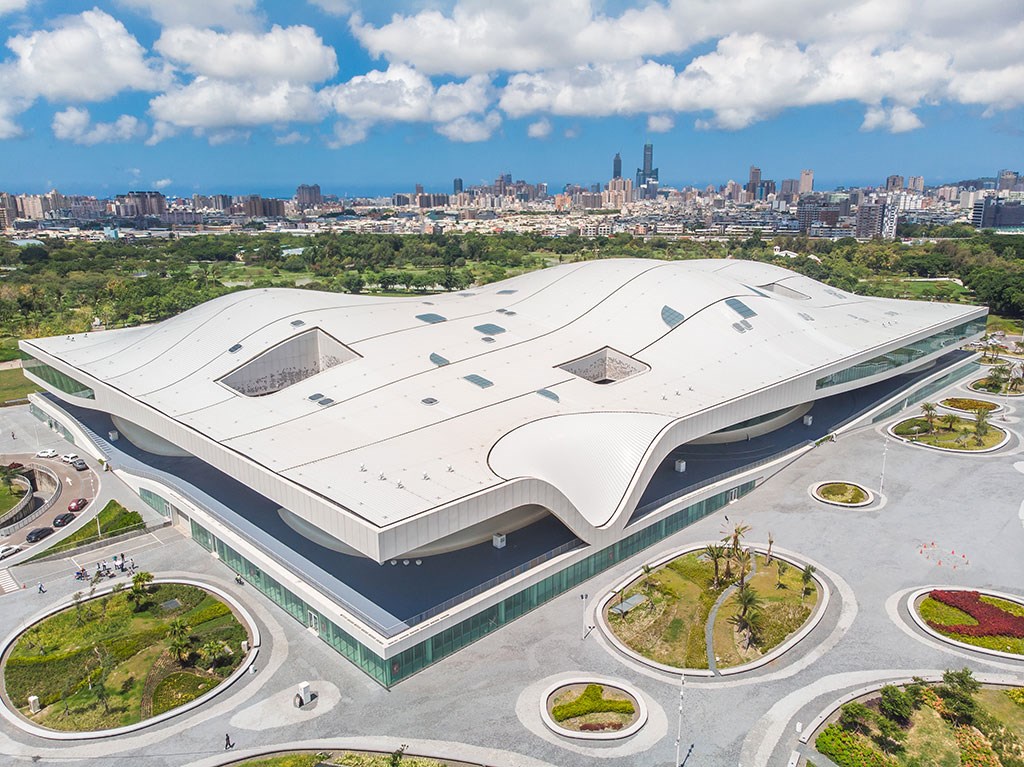
National Kaohsiung Center for the Arts (Weiwuying)
Wei Wu Ying Cultural Center is located at the site of a former military barracks in Fengshan District, Kaohsiung City. The 66.6-hectare site is home to southern Taiwan's first international performance art venue and the largest performing arts and music hall in is East Asia. Scheduled to open in October 2018, the center will also provide space for art education and talent development in southern Taiwan.
-
v
v
v
-
4-star or 5-star hotel in Kaohsiung
Morning: traveling to Kenting
Afternoon: National Kenting Park
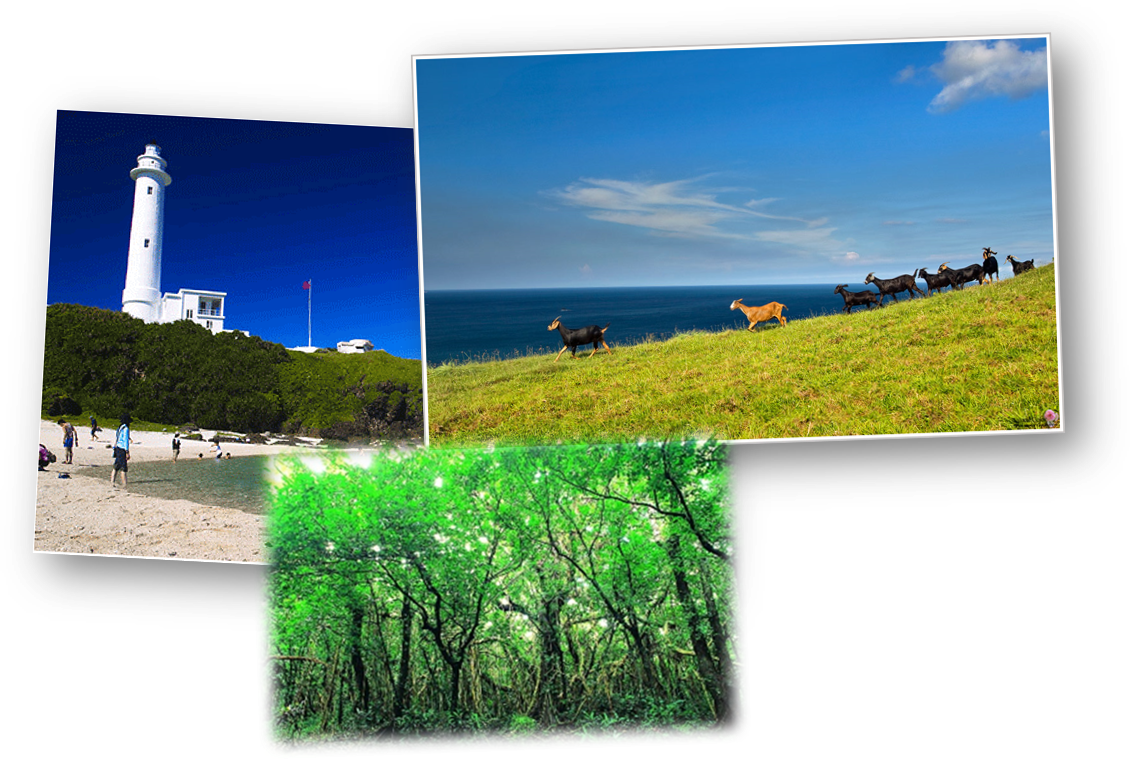
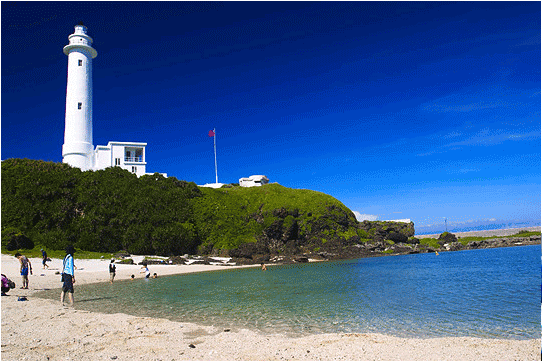
Eluanbi Park
Kenting's rugged coastline provides some of the area's most outstanding attractions. The most prominent of these must be Eluanbi, also known as "Taiwan's Tail." This is the island's southernmost point.
Eluanbi Park was created in 1982 to provide an appropriate venue for people coming to visit Taiwan's southernmost point and one of the peninsula's most notable landmarks, the Eluanbi Lighthouse, also called "The Light of East Asia." It stands 21.4 meters high and is reputedly the brightest lighthouse in Asia. The park covers an area of 59 hectares. Within the park there are a number of recreational facilities and a wide range of interesting geological, botanical, and ornithological features. The area covered by the park is also one of the sites of Kenting's prehistoric cultures.
National Kenting Park
The centerpiece of the Hengchun Peninsula is Kenting National Park, Taiwan's only tropical national park. Established in 1982, Kenting National Park covers a total area of 33,268 hectares of land and maritime environments.
This is Taiwan's most densely populated national park, and it includes large stretches of agricultural land's providing visitors with a view of typical Taiwanese rural life. In addition, the national park includes mountains, forests, pasture, lakes, sand dunes, beaches, and coral reefs imply everything you could desire when you want to get up front and personal with Mother Nature.
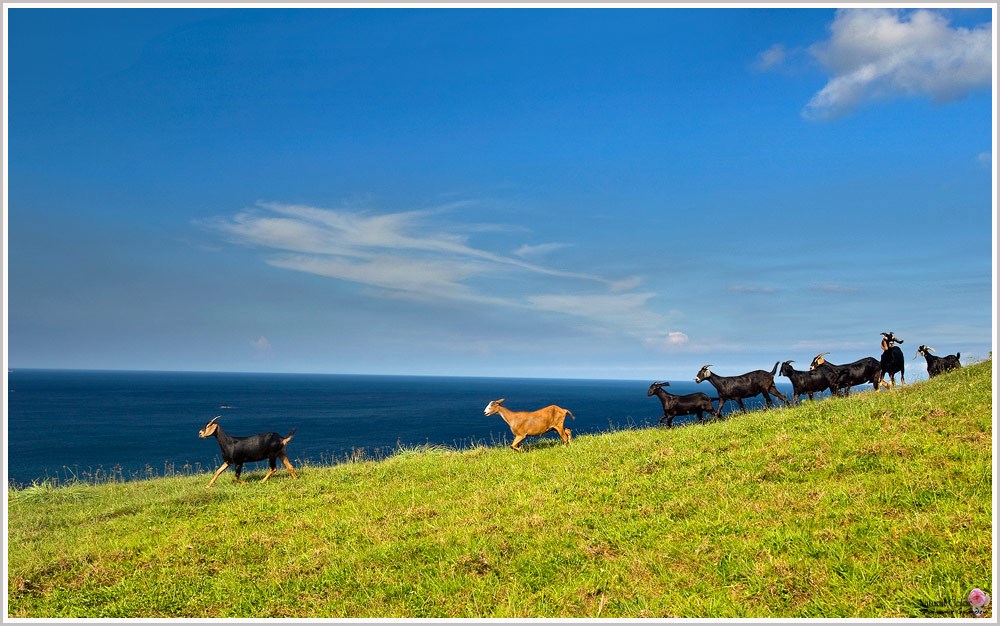
-
v
v
v
-
4-star or 5-Star Hotel in Kenting
Morning: Erluanbi Lighting Park
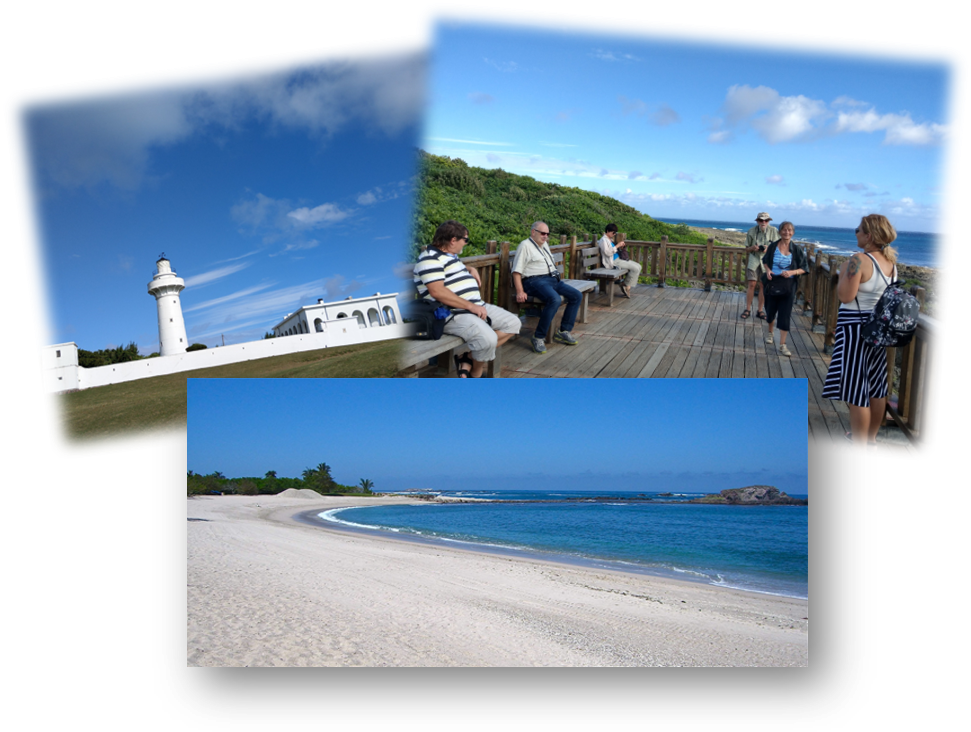
Afternoon: Taitung Tie Music Village / Beinan Culture Park
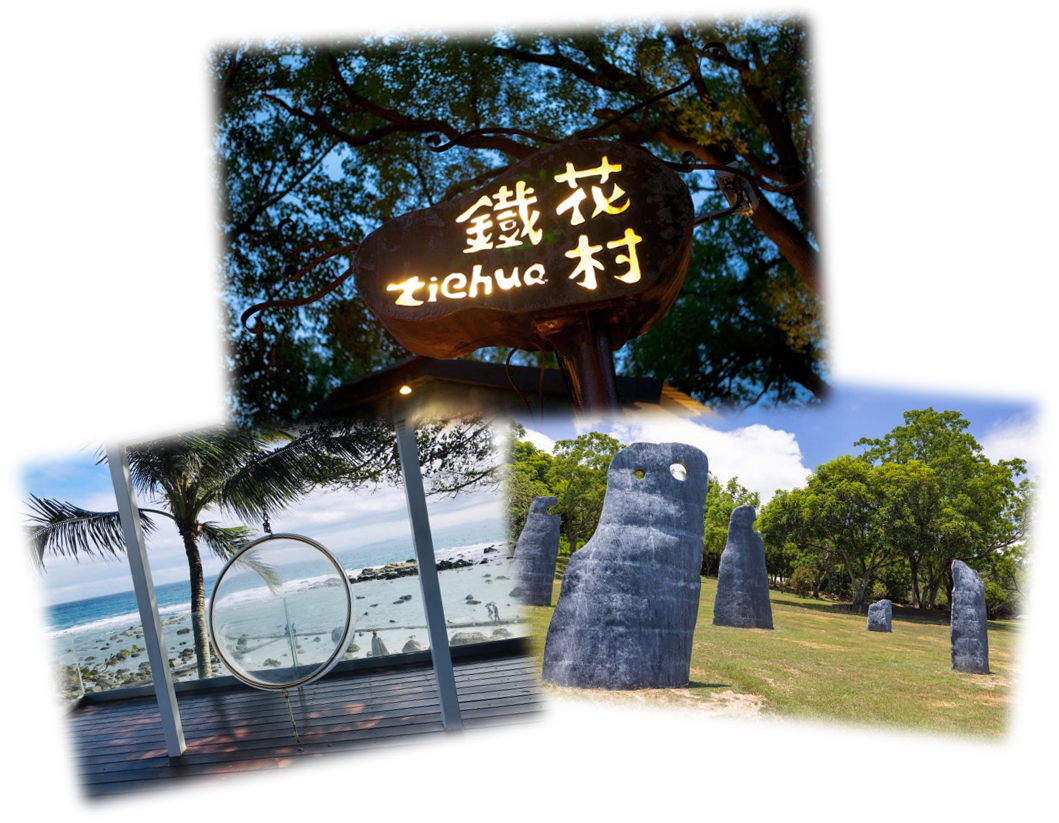
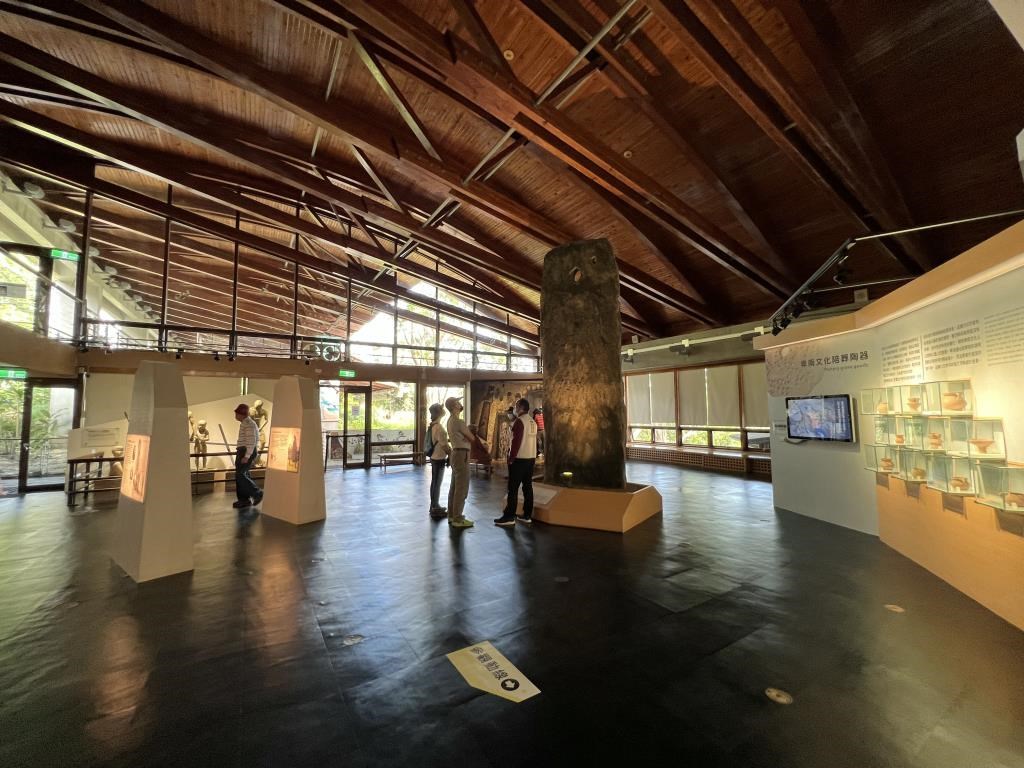
Beinan Site
Beinan Site Park is situated at the northern edge of Nanwang Village of Beinan Township in Taitung County. This is the site of the largest and most complete prehistoric settlement that has been discovered in Taiwan so far; in its heyday, the settlement may have covered an area of more than 300,000 square meters. It was found during construction work on the back part of Taitung's New Railway Station when the South-Link Railway was being built in 1980, when a graveyard containing several thousand slate coffins was unearthed. This is the largest prehistoric graveyard yet discovered around the Pacific Rim. The bringing to light of this cultural layer from under the ground caught the attention of the government, and in addition to the carrying out of archaeological work there a national museum to house the resulting artifacts was also built. Besides the coffins, the remains of buildings as well as implements of life used by the Neolithic Beinan people who lived here 2,000 or 3,000 years ago. From their pillared houses, the rich forms of the artifacts they left behind, the exquisite nature of their handicraft, and their burial customs we can catch a glimpse of the high level of civilization attained by these people. In addition to the museum, the park contains the archaeological site that you can visit; if you make prior arrangements for a volunteer guide, you can even have a guided tour of this interesting site.
Zhiben Hot Springs
Zhiben (Jhihben) Hot Springs have the reputation of being "the greatest scene in eastern Taiwan." In the early years, hot springs emerged from riverbeds. There are carbonic acid springs (with the nature of base). There are colorless, odorless and their temperature reaches more than 100 degrees (Celsius). The springs are of high quality.
Zhiben (Jhihben) is divided into the inner hot spring area and the outer hot spring area by the Zhiben (Jhihben) Creek. Inner hot spring area was developed late. However, due to presence of five-star resorts, the area has become the largest business district. It attracts many foreign tourists who demand services of higher quality.
The "Zhiben (Jhihben) Hot Springs" generally known by the public is located in outer hot spring area. There are many middle-size and small hot spring inns. It is convenient to get accommodation or enjoy hot spring spa. Now the inner hot spring area and the outer hot spring area have expanded and joined together. However, the inner hot spring area is close to Zhiben (Jhihben) Forestry Park and its scenery is even better.
Zhiben (Jhihben) Hot Springs are the gathering place of aboriginal people. It provides the delicious dishes of aboriginal people and country dishes. Other than stores of country dishes, there are venders selling fruits like Shijia (sugar-apple), pineapple and Luoshenhua (roselle). It has the flavor of eastern Taiwan.
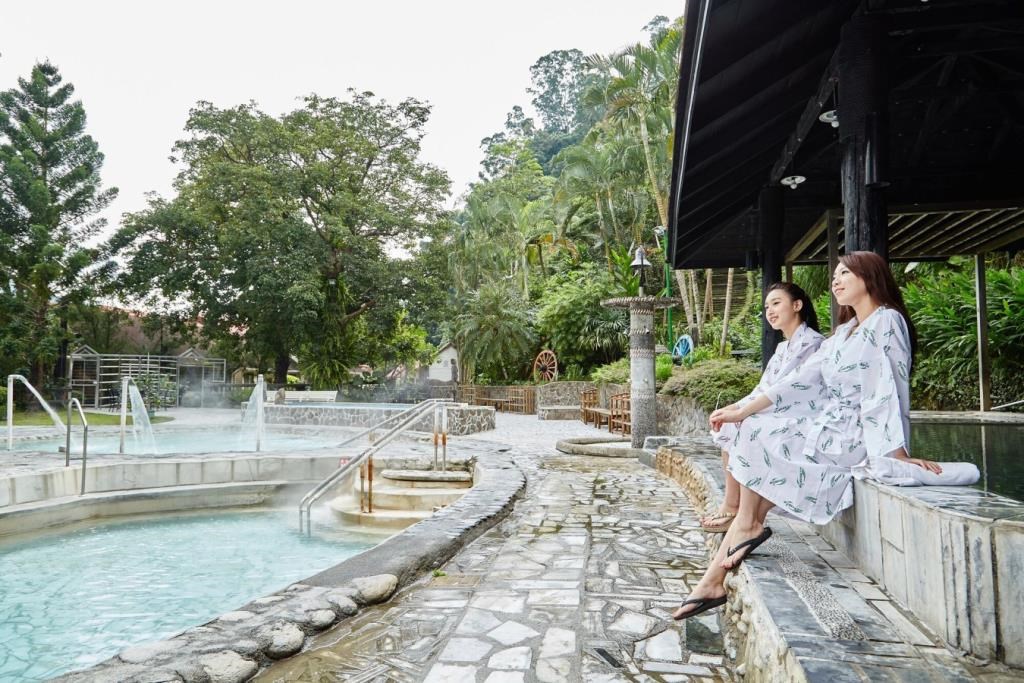
-
v
v
v
-
4-star or 5-star hotel in Taitung
Morning: Sanxitai /Xiao Yehliu
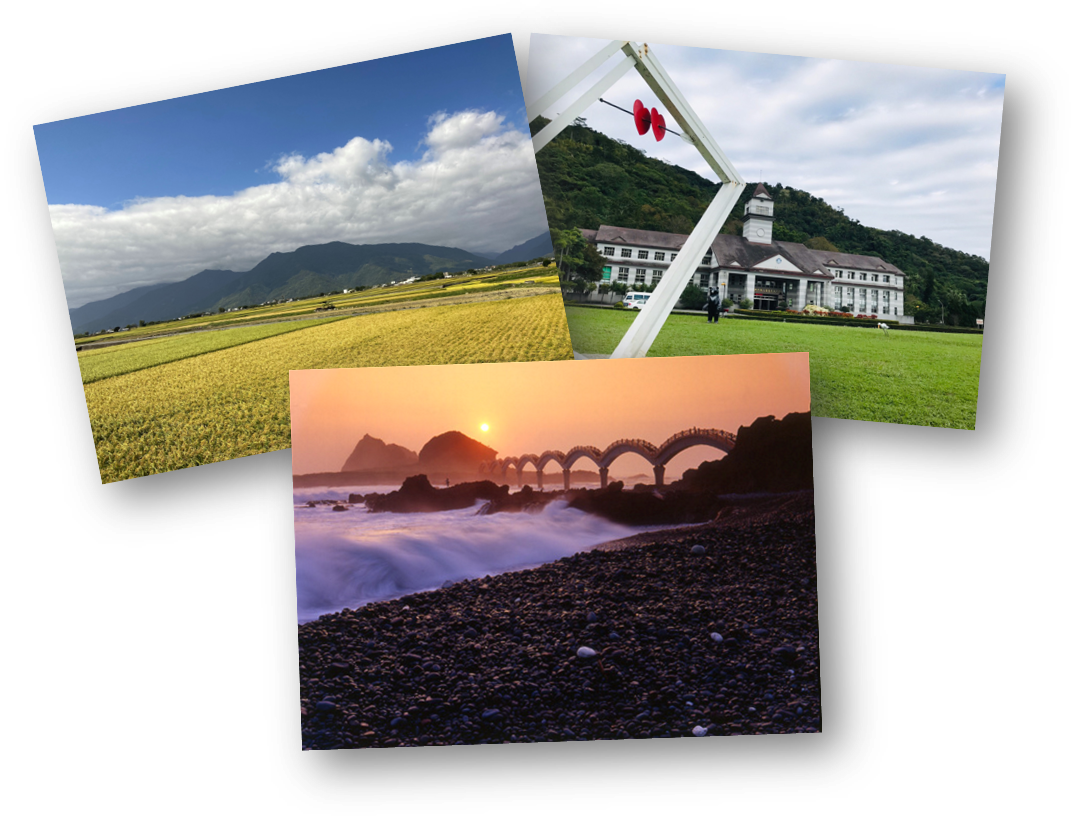
Afternoon: National Taroko Park /Cingshui Cliffs/Eternal Spring Shrine/ Buluowan
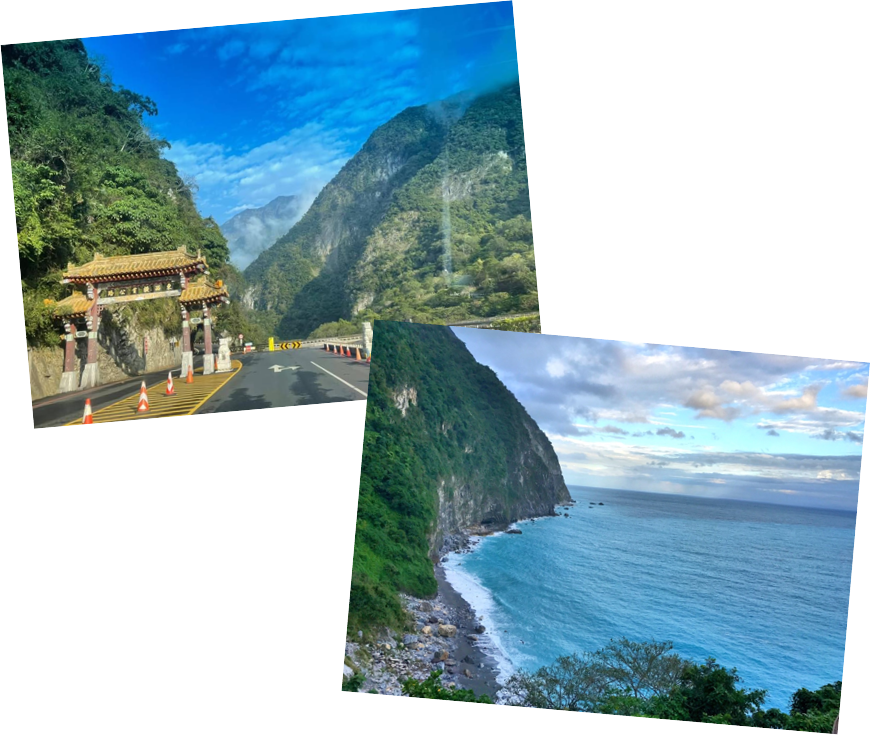
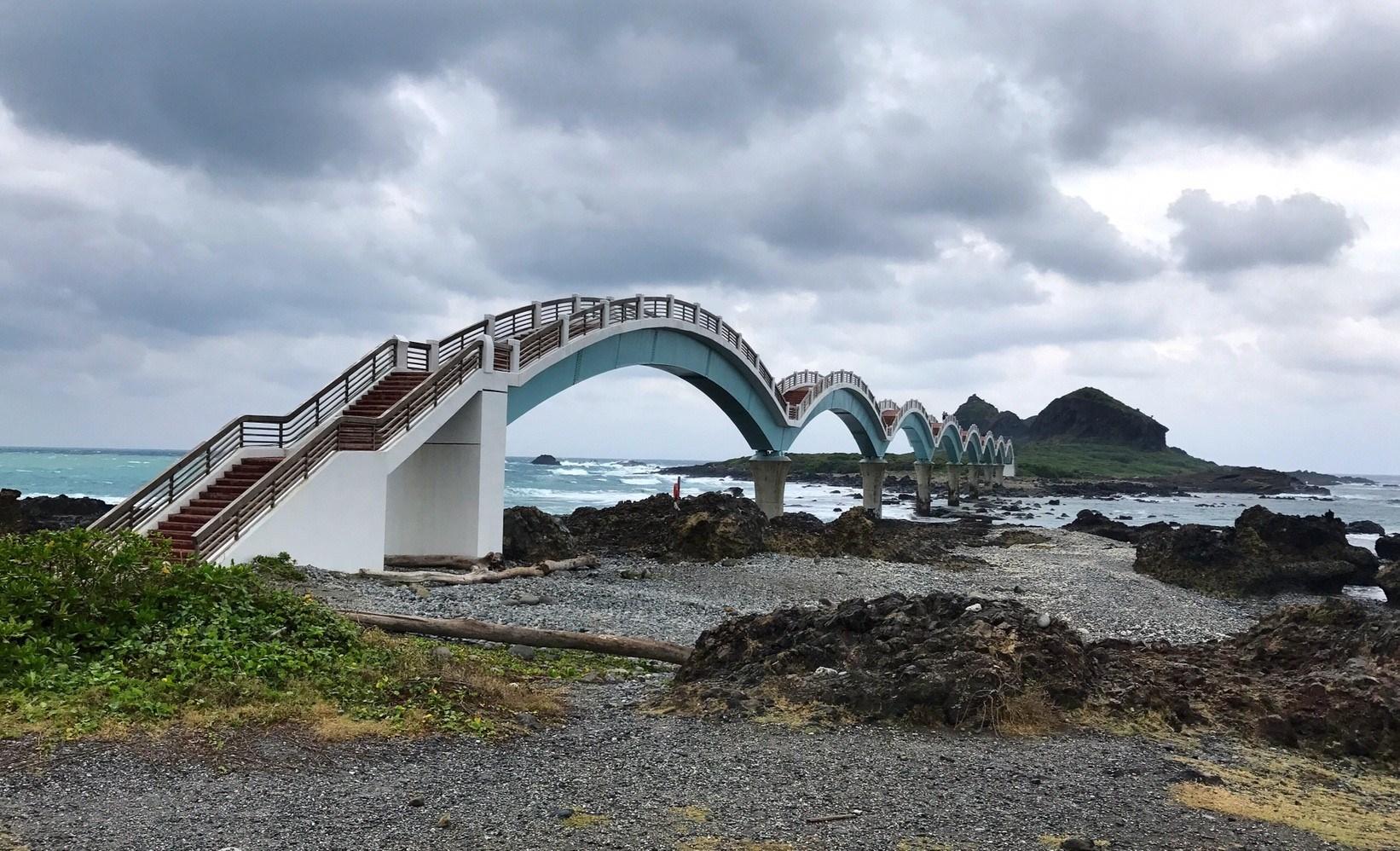
Sanxiantai
Situated at the 110.5-kilometer mark on the coastal highway, Sanxiantai consists of a headland facing a small island in the sea. The three huge rocks that make up the island's most prominent feature have given rise to a local legend that three of China's Eight Immortals once landed there; hence the name of the island, which means "terrace of the three immortals." The island was once connected to the headland by a neck of land which has been eroded away; it is now connected by a red, scalloped footbridge, and the island has a network of footpaths for viewing its geological features such as potholes and sea-eroded caves and trenches, as well as rare coastal vegetation. The island is surrounded by coral reefs and a multitude of tropical fish, making this an ideal spot for skin diving.
Sanxiantai Visitor Center
Sanxiantai is one of the most popular scenic spots in East Coast. You can find out more about these natural wonders and ecology of this area before departing on your tour from the Sanxiantai Visitor Center.
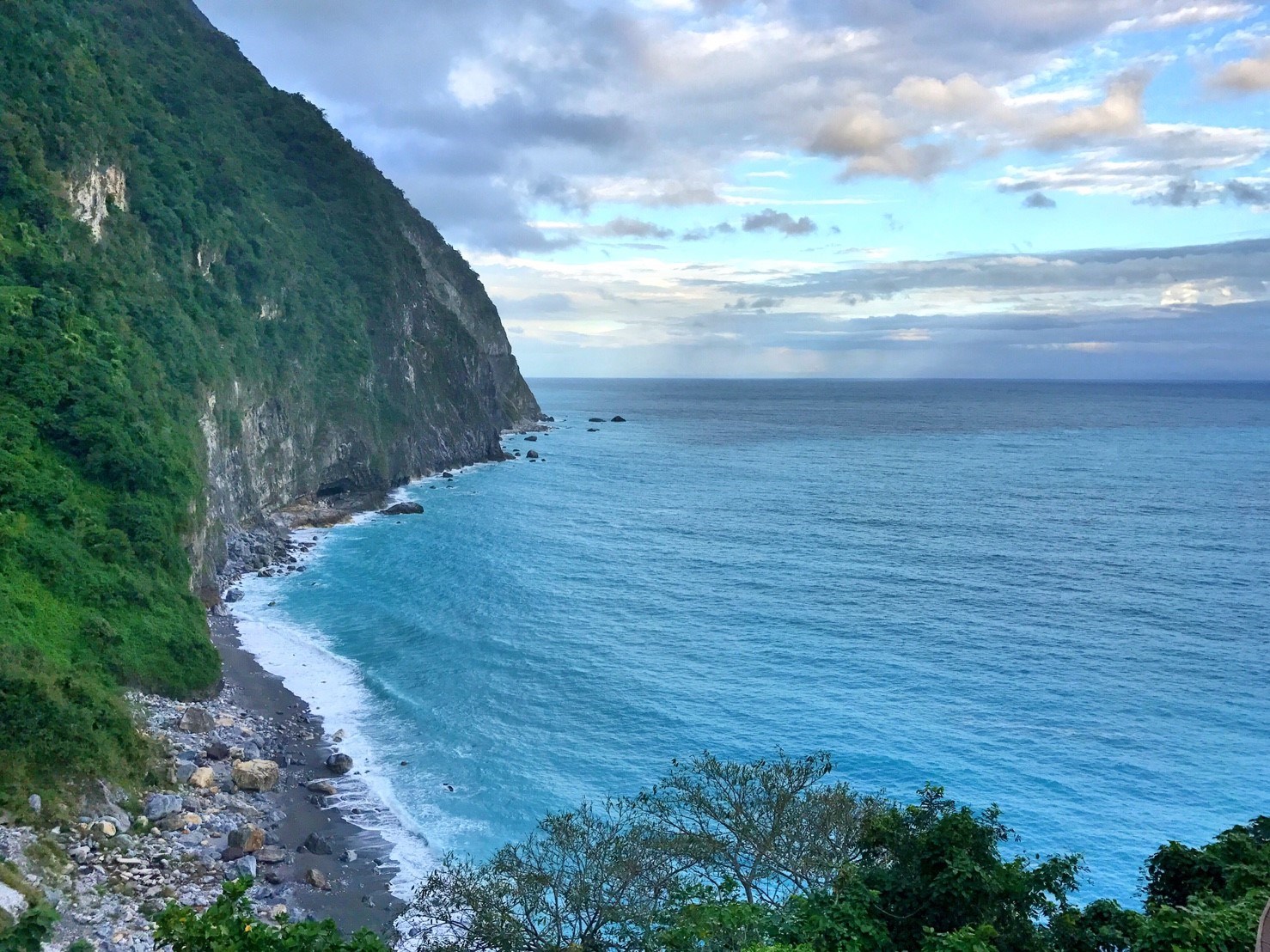
Qingshui Cliff
Qingshui Cliff, located on the section of the Suao-Hualien Highway that stretches between Heping and Chongde stations, is one of the most spectacular sights on Taiwan's Pacific coast. The cliff is more than 1,000 meters high and drops almost vertically into the sea. The highway snakes along its curving face more than 20 kilometers, with the sheer cliff rising on one side and a sheer drop to the ocean on the other.
National Taroko Park
The Taroko Gorge is a spectacular 19-kilometer long canyon in Taiwan's east coast a short drive from Hualien. The climate is usually cool and humid, but again perfect for any of the trekking options at any of the long or short trails available, biking or whitewater rafting.
It's just over 60 kilometers from the coast, yet it is home to some of the highest peaks in Taiwan at over 3,400 meters.
It can be easily visited by bus, car or scooter and has enough treks to keep you busy for several days, but most people usually only visit it on one.
-
v
v
v
-
Taroko Village Hotel or Silks Place Taroko
Morning: Baiyang Trail / Baiyang Waterfall
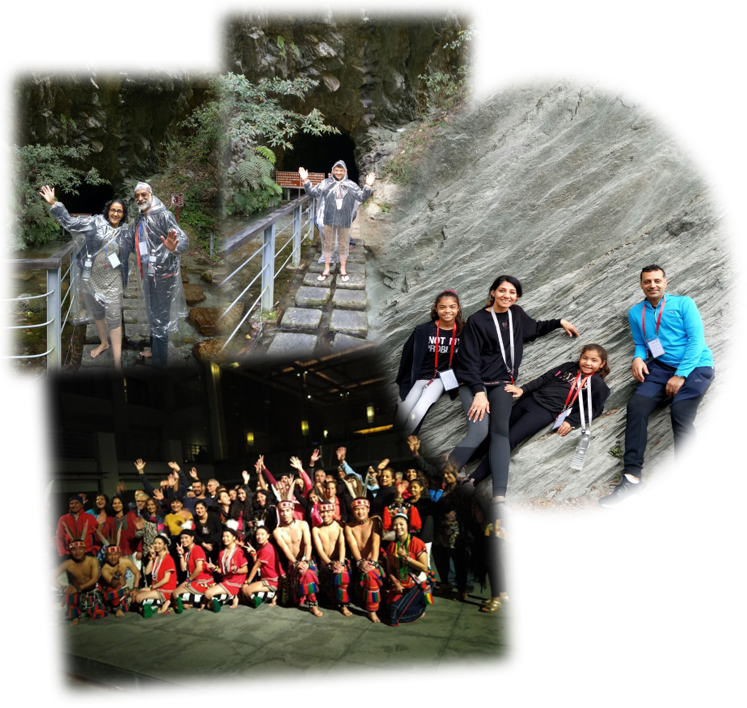
Afternoon: Tunnel of Nine Turns / Swallow Grotto
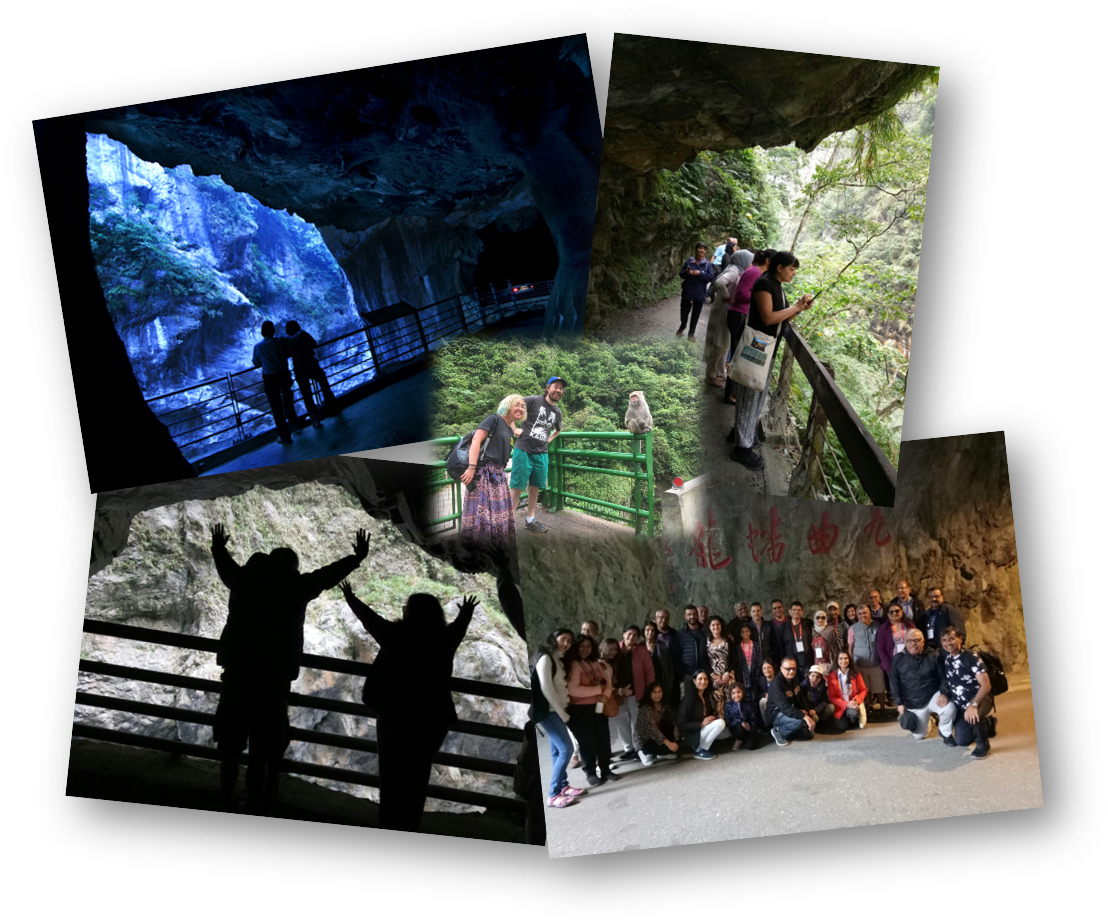
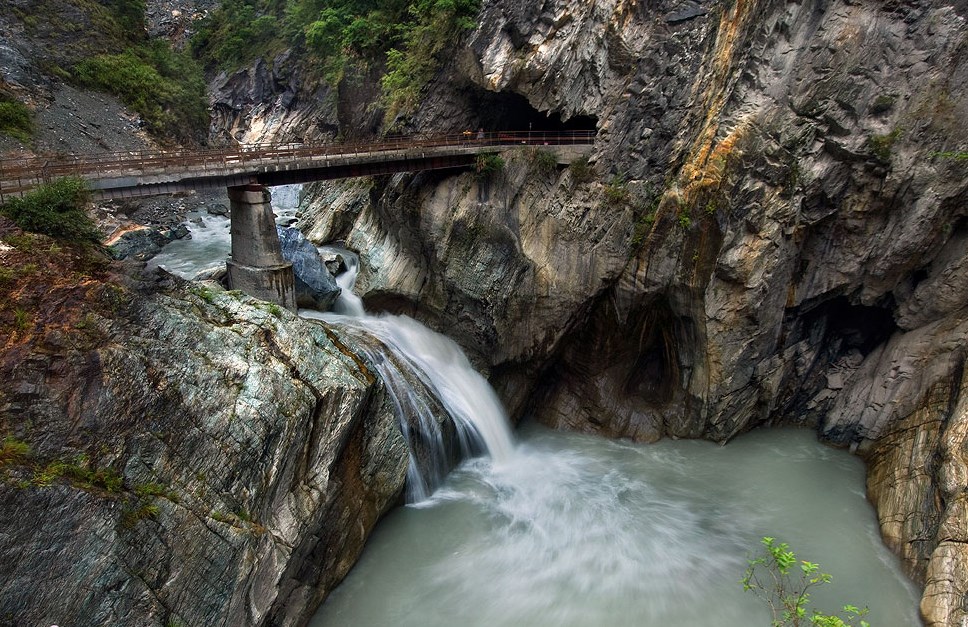
Baiyang Trail
The entrance of the Baiyang Trail is located about 300 meters from Tianxiang on the Central Cross-Island Highway. Near Wen Mountain (Wenshan), hikers will come upon the tunnel that is the beginning of the Baiyang Trail. Along the trail there are six tunnels of different lengths that provide a certain frisson as groups feel their way through the semi-darkness. The longer tunnels have solar-powered lights. This trail is particularly popular with locals, for it has an atmosphere of mystery and romance. A turn in the trail at the end of the third tunnel offers an excellent view of Tacijili River, and at the end of the sixth tunnel the truly spectacular goal of the trail, Baiyang Waterfall, comes into view. The water roars as it plunges into the deep pool that it has worn in the rock. The Baiyang Suspension Bridge offers spectacular views of the waterfall and the river valley. A seventh tunnel leads to a cave behind the falls; because of the danger of falling rocks, this area is closed to the public. Although this trail is not physically challenging, additional clothing may be necessary to ward off chilly air in the vicinity of the Baiyang Waterfall and back takes approximately 1.5 hours.
Swallow Grotto
This part of Taroko Gorge is composed of marble cliff faces covered with small holes, the result of long-term erosion by river and ground water. House swifts and Pacific swallows often forage and nest here, giving the place its name.
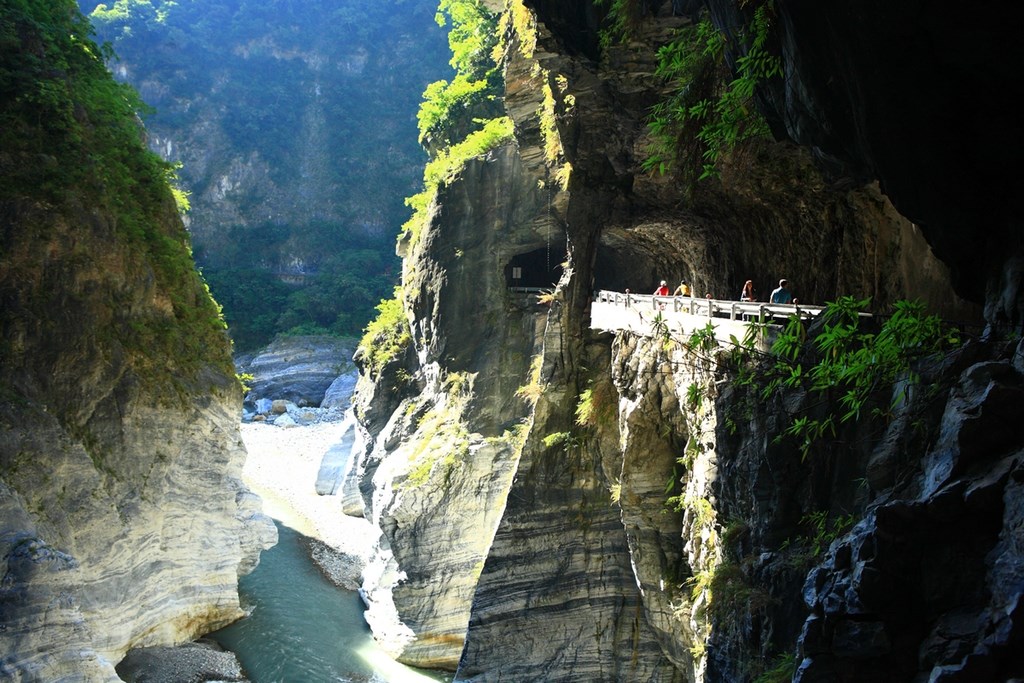
Tunnel of Nine Turns
The tortuous course cut by the river has produced a gorge of many curves, and the path of the highway that has been carved out of the cliff face here seems to be an endless aerie of turns. Hence the name, the gorge is so narrow that only a very narrow width is open to the heavens, in what the Chinese call "a thread of sky." The marble cliff face opposite the highway varies in color from deep gray to pure white in a multitude of changing designs. A walk through the Tunnel of Nine Turns takes about 30 minutes and gives access to enchanting scenes of the gorge, the river, stone strata, the tunnel itself, and the surrounding vegetation. This is one of the most scenic parts of the gorge, and the best place to observe the gorge's ecology.
-
v
v
v
-
Taroko Village Hotel or Silks Place Taroko
Morning: National Center for Traditional Arts/ Lanyang Museum
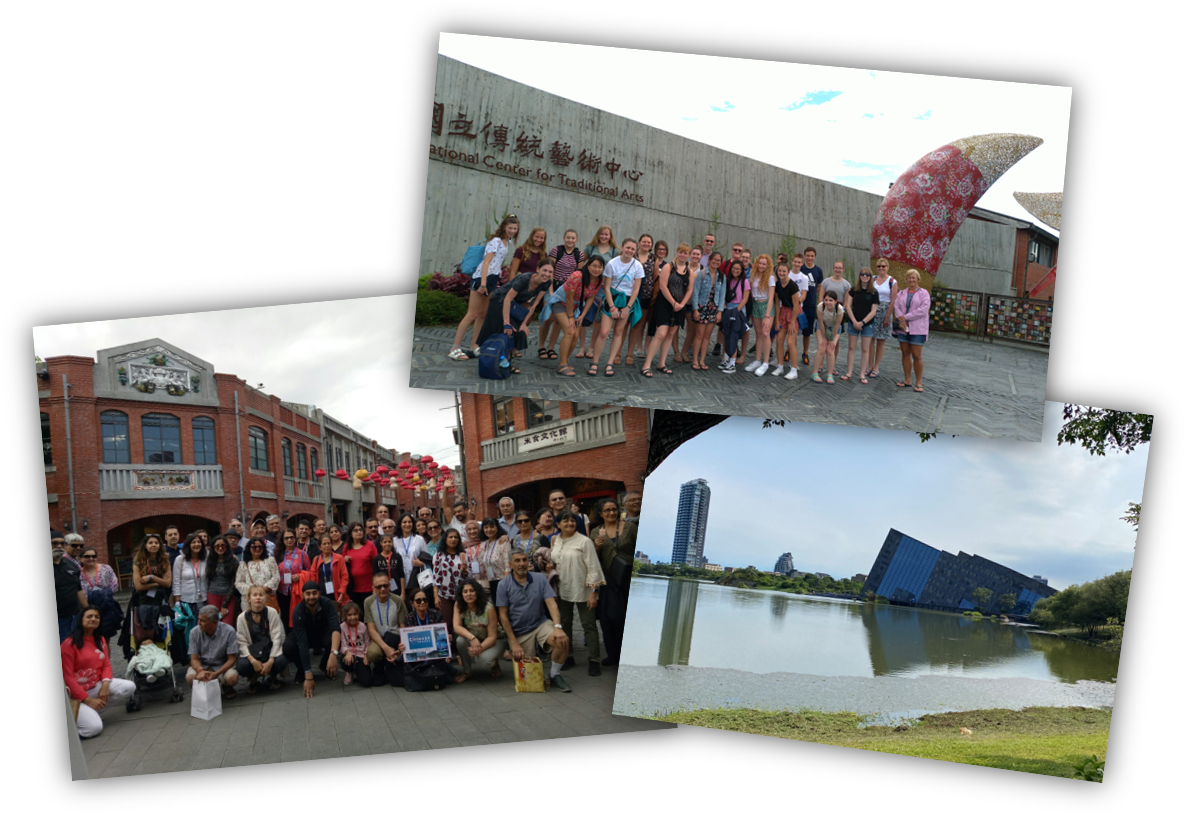
Afternoon: Yehliu Geopark / Keelung Temple Night Market / Taipei
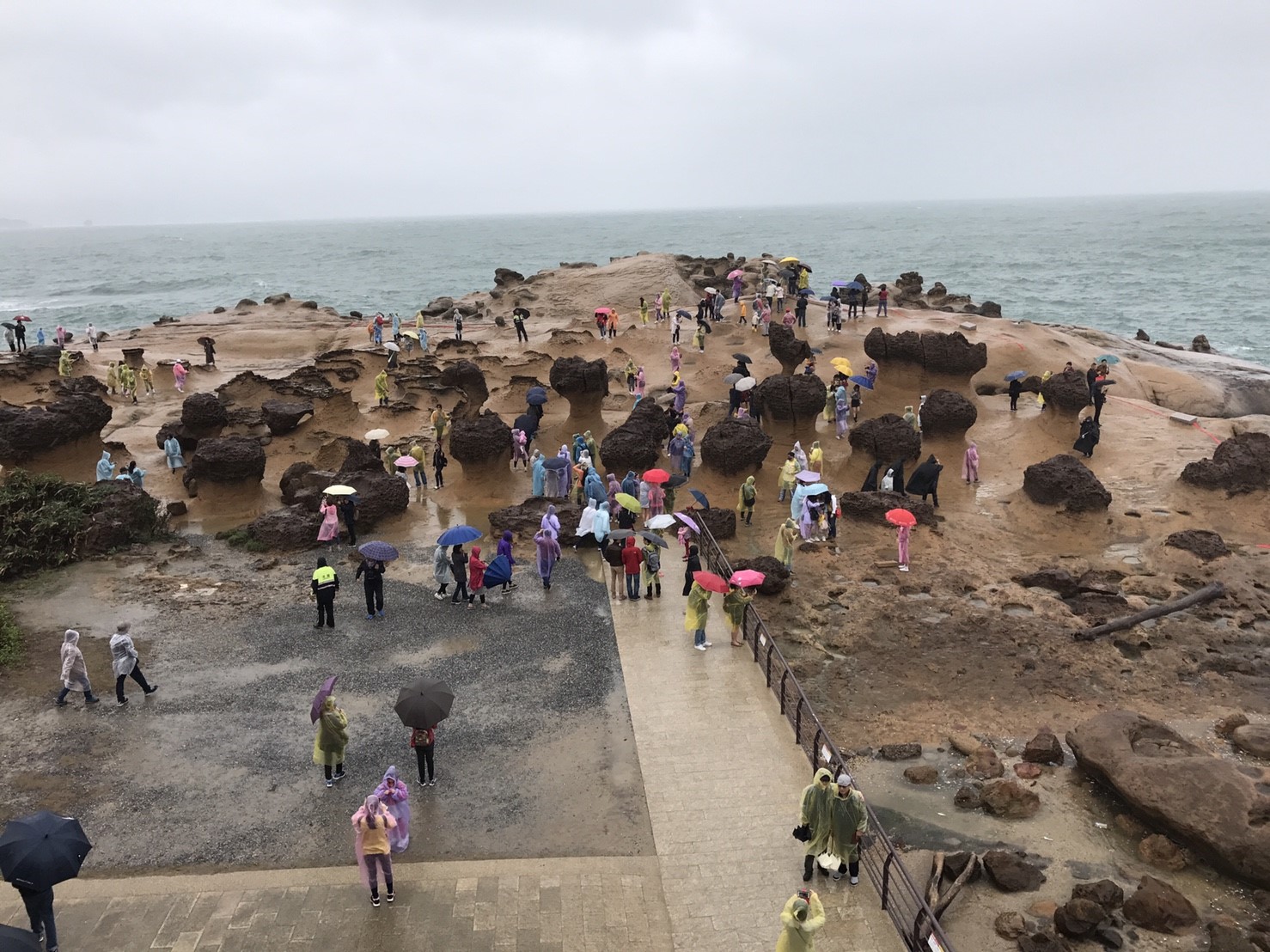
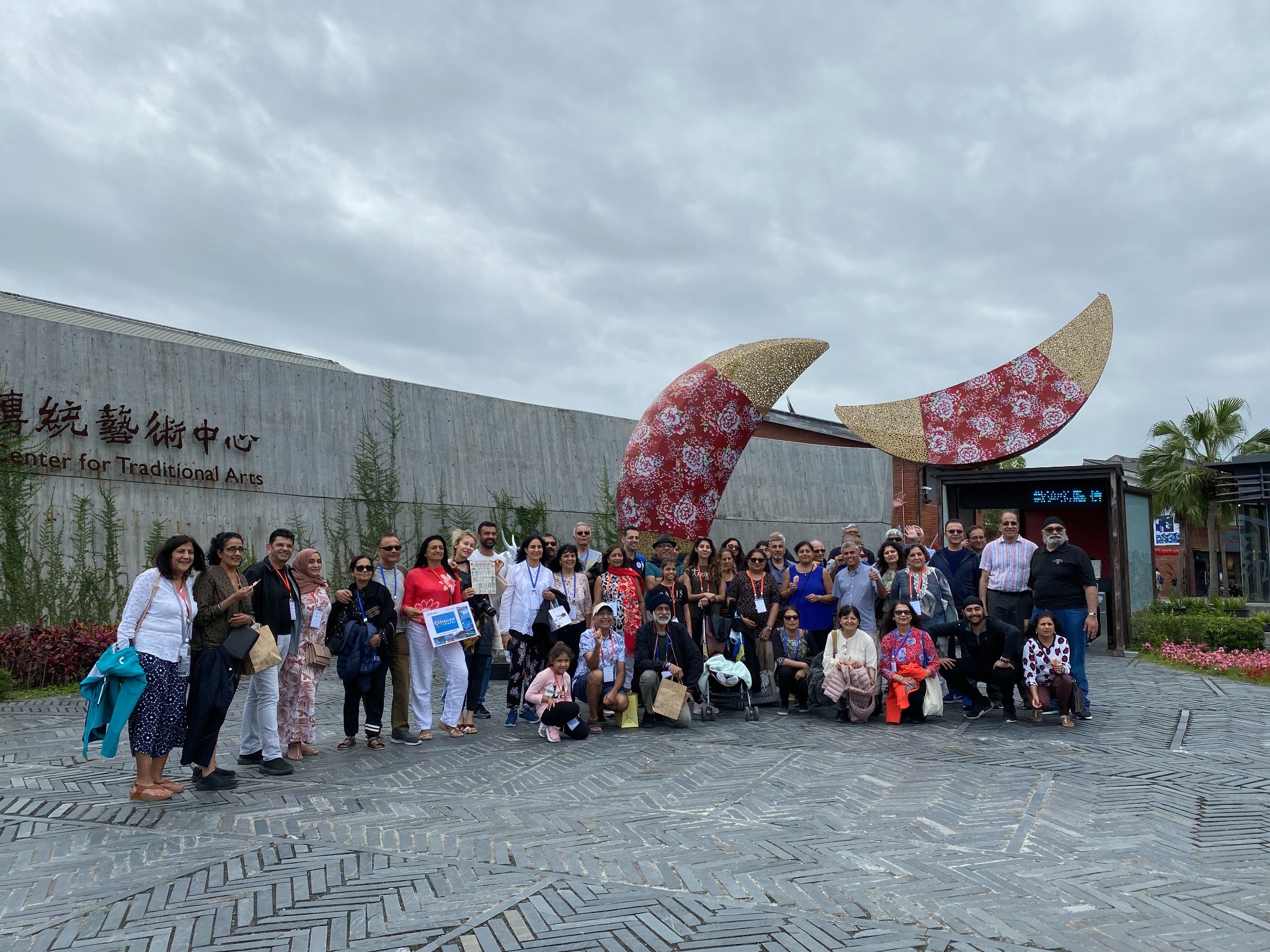
National Center for Traditional Arts, Yilan
This new 24-hectare facility is located beside beautiful Dongshan River in Yilan. In addition to organized displays and performances of culture and art, it also provides a stage where performing artists can show off their creative works. The emphasis here is on the continuous propagation, innovation, and renewal of traditional arts. You can stroll casually among artistic creations, listen to elegant music, and enjoy exciting opera performances—and you can even participate in the process of artistic creation yourself. From the Center, you can take a boat and visit the Dongshan River Water Park.
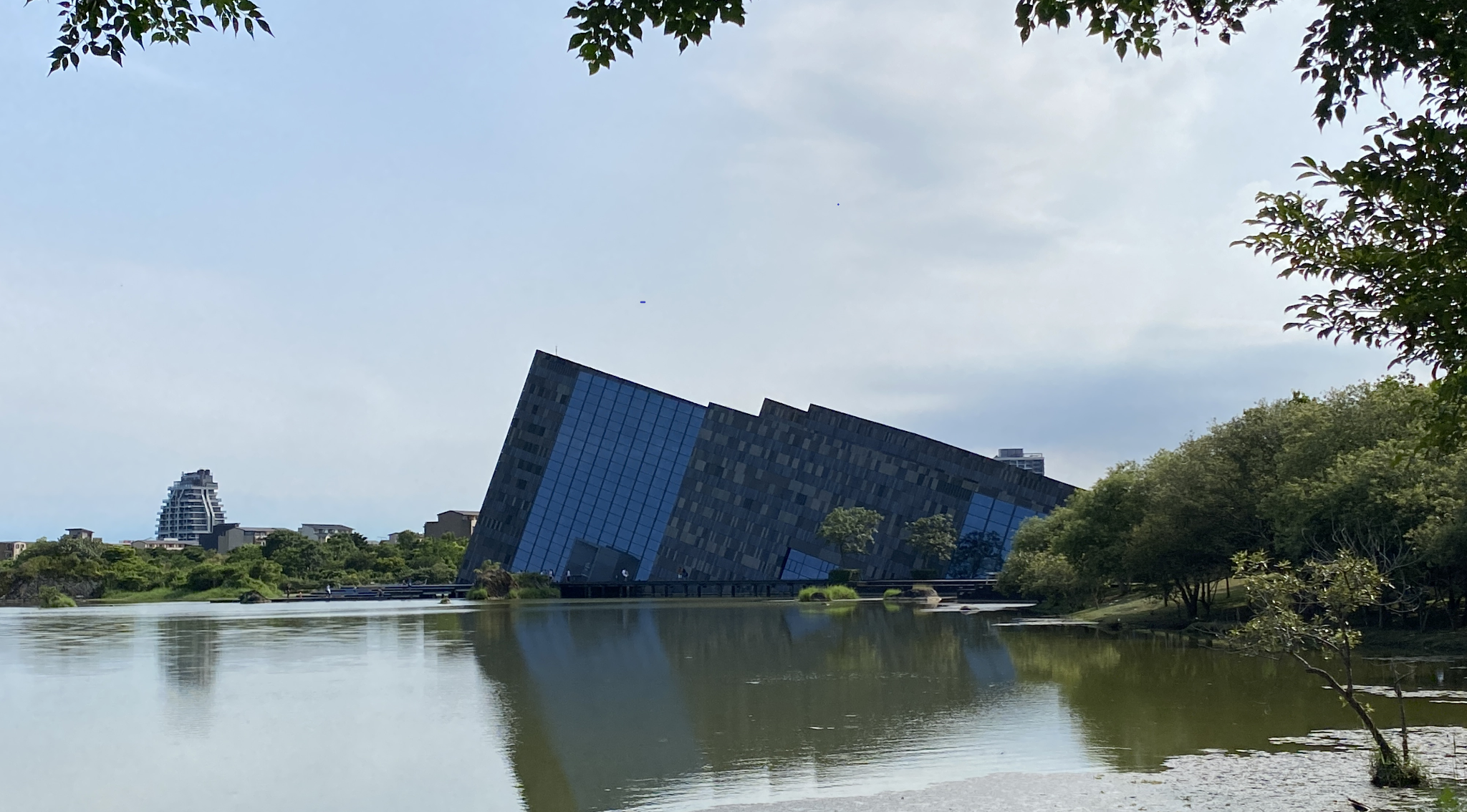
Lanyan Museum
Yilan itself is a museum
Rich in both natural and cultural resources, the Lanyang Plains are characterized by ecological and ethnic diversity, warm and friendly people, and a vibrant culture. It is said that Yilan itself is a museum and we believe the Lanyang Museum serves as a sort of window to those wishing to learn more about Yilan. The Lanyang Museum's mission is to bring together Yilan's local resources through books and displays as well as tourism and recreation to promote activities of museums throughout the county to ensure the sustained development of "the museum that is Yilan."
At Yilan's cultural and historical epicenter
The Lanyang Museum is located on the site of Wushi (Literally, "black rock") Port which during the Qing Dynasty bristled with the masts of the vessels coming and going. The harbor was not only an artery for the physical materials needed by the people of Yilan, it was an important hub of cultural exchange with the outside world. The Lanyang Museum was erected on this site to symbolize the fact that culture in Yilan is breaking new ground and reaching new heights and milestones.
One with the land
You might be curious as to why our building looks so different. The architecture of the Lanyang Museum was inspired by natural elements found locally. Architect Kris Yao incorporated the cuesta, a gently tilting stone escarpment common to Taiwan's northeast coast, into the building's design, allowing structure to blend into the natural environment. From a distance, it resembles a huge black rock; up close, you discover a place of unique beauty that coexists in harmony with the land.
Permanent displays
Upon entering the Lanyang Plains, you note the blending of mountain and sea. In the museum's exhibition area, therefore, we have set up displays reminiscent of the geographical and spatial characteristics of Yilan. They hint at the local mountains, plains, and ocean and convey the idea of interacting with the

Yehliu Geopark
Yehliu is a cape of about 1,700 meters long formed by Datun Mountain reaching into the sea. When overlooked from above, the place is like a giant turtle submerging into the sea. Thus, it is also called "Yehliu Turtle." Because the rock layer of seashore contains sandstone of limestone texture and it is subject to sea erosion, weathering and earth movements, there is particular scenery consisting of sea trenches/holes, candle shaped rocks, and pot shaped rocks. The place is divided into three sections. The first section has rocks like Queen's Head, Fairy's Shoe and Candle. The second section has rocks like Bean Curd, Dragon Head. The third section has sea-eroded caves, seal shaped rock, etc. The place is suitable for geological study and field research. In addition, there is a statue of Lin Tien Jane in commemoration of the person's bravery of scarifying own live for saving others. The monument describes in details the touching story.
-
v
v
v
-
4-star or 5-star hotel in Taipei
Morning: PingXi Lantern Trip - Lantern Police Station - JingTong Old Street - PingXi Old Street - Shihfen Water Fall - Lanter Releasing
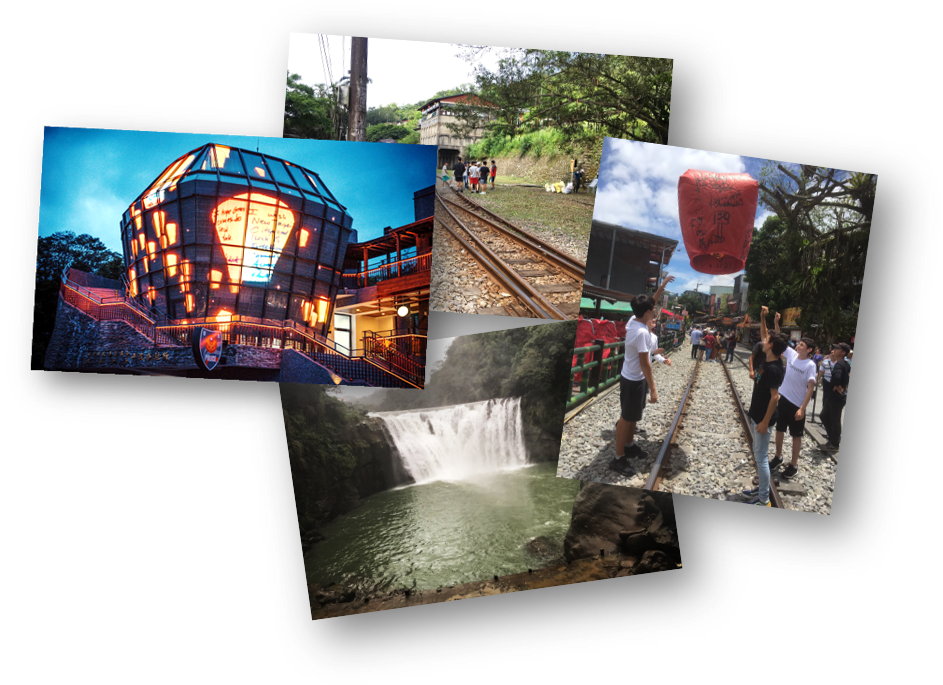
Afternoon: Taipei 1914 Creative Park - Hsingyi shopping area - Taoyuan International Airport for Departure
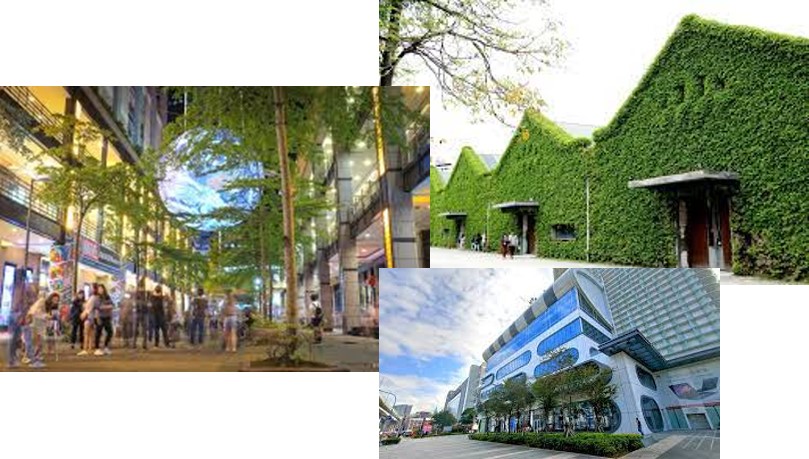
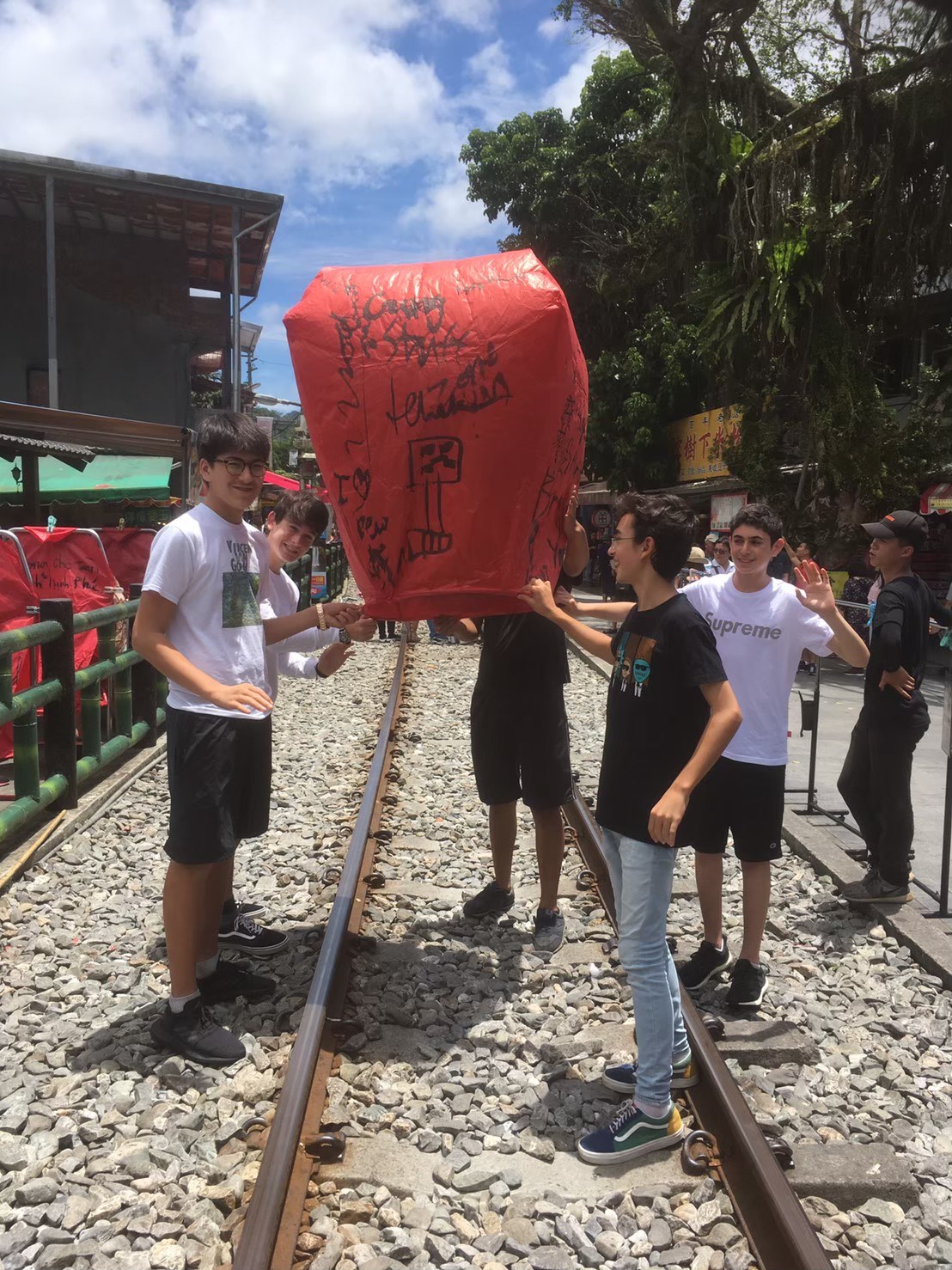
PingXi Sky Lantern
Pingxi and Shifen are just two of several towns alongside highway 106, a narrow back road that runs between southern Taipei and southern Keelung. Pingxi Sky Lantern Festival is one of the three most popular and well-known celebration event during the Lantern Festival. Since 1999, the local Government has devoted substantial resources to promote this festival, in a bid to promote it to become an international and multi-ethnic culture exchange activity. Through this festival, presenting the Sky Lantern tradition and the natural beauty of Pingxi to the public and prayers to the heavenly God and wishing for prosperity and peace for the nation and its citizens.
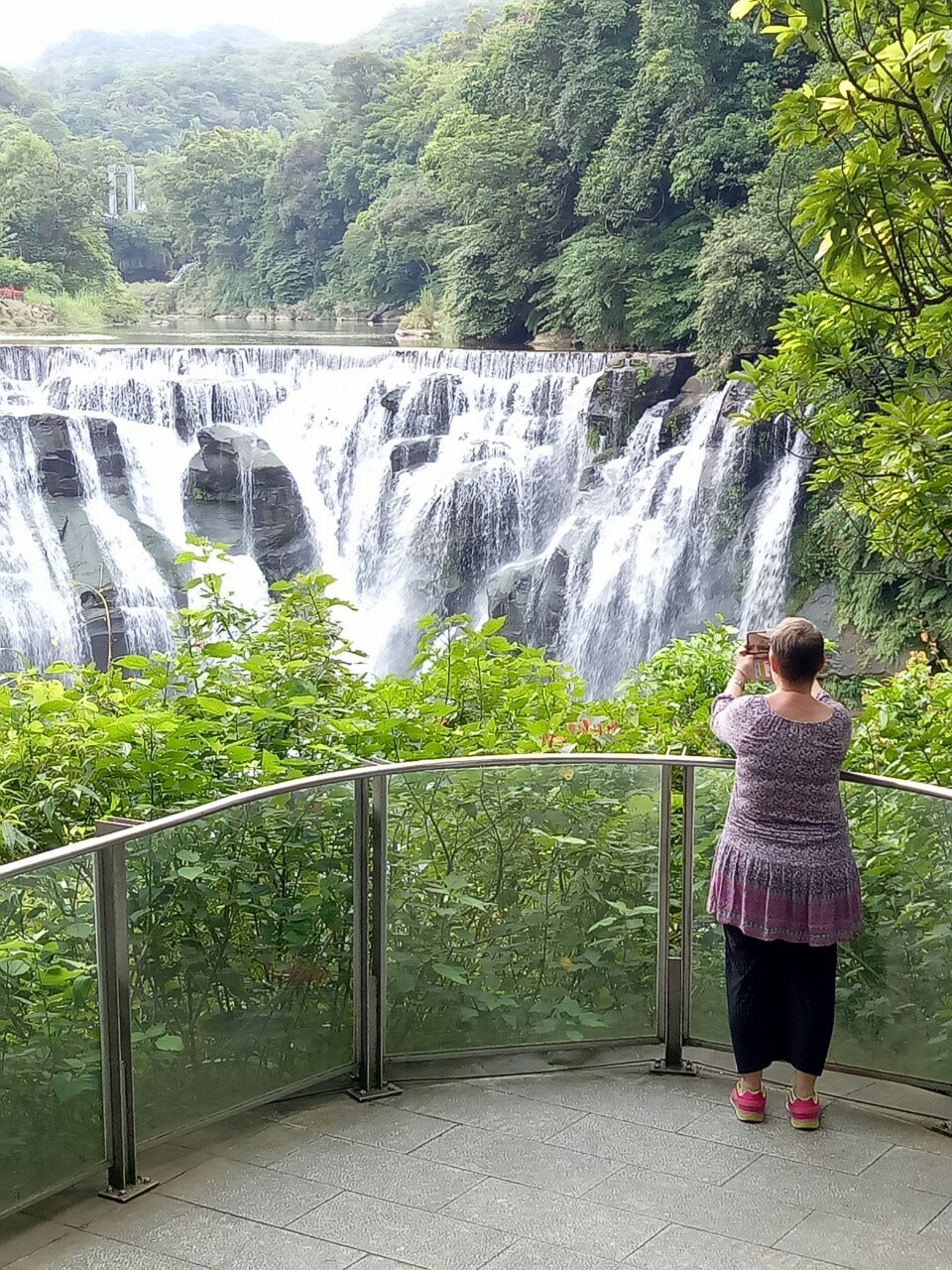
Shifen Waterfall
Shifen Waterfall
Shifen Waterfall lies between Dahua Station and Shifen Station on the Pingxi Railway Line in Pingxi District, New Taipei City. Torrents of water thunder down this curtain-type fall like a white satin sheet. As the water plunges into the large, deep pool beneath, it raises mists that often enshroud the falls. On sunny days, the mists paint dazzling rainbows in the blue skies: a sight that has earned the waterfall pool the nickname of "Rainbow Pond." Because its bedrock slopes in the opposite direction of the water flow, Shifen Waterfall is a cascade-type waterfall similar to North America's Niagara Falls, earning it the nickname of "Taiwan's Niagara Falls."
Hwashan 1914 Creative Park
Huashan 1914 Creative Park is located at the site of the former Taihoku Winery. The buildings here were constructed by the Japanese in 1914 as a sake plant and were later re-purposed as the Taihoku Winery. After the winery relocated in 1987, the plant remained as a museum of industrial building technology. Since 1999, this site has grown as a venue for art and cultural exhibitions and performances, as well as a place for artistic creation by individuals and organizations. The park is home to a number of restaurants, art galleries, cultural and creative stores, and performance venues. Exhibition and performance spaces are also available for rental, further making this a center of Taiwan's cultural and creative industry.
-
v
v
v
-
-
